#but for the most part I’m still experiencing the game/plot/story with not much spoiled and I have been enjoying it so far personally
Explore tagged Tumblr posts
Note
Ahhhhh yes wonderful! That is A: absolutely the goal when I write something THANK YOU SO MUCH and also B: how I like my stories too. I would much rather have a story where I can see each step of the plot than one that just lurches in and catches me off-guard with a “ha ha surprise twist!” Especially when it’s something that’s implausible, shocking, or terrible: I want the mounting anticipation or dread more than just a fleeting moment of “oh wowserz didn’t see that coming!” which is so much less satisfying imo. Even if I didn’t cotton-on ahead of time, I’m still more delighted by a story where you can see the twist in retrospect than one that’s “surprising” because it never bothers to set the twist up at all.
See: soooo many modern action/superhero movies ugh. It seems to be a common fallback for some writers now to engender a moment of shock and awe in order to cover for the fact that they’re failing to establish a proper emotional arc or connection that would make people react like that even without the shock. (That’s why they’re so obsessed with “spoilers” now. If one single spoiler would ruin your whole film, it’s probably not a good film buddy.) We all know who Luke Skywalker’s father is now, and ESB remains a fantastic film because it’s got the same emotional weight regardless of whether the audience is gasping in surprise or not. There’s such a difference between “don’t spoil this twist so that other people can experience it for themselves” and “don’t spoil this twist because without it there’s no point to the whole damn movie” lol.
And apparently I feel rambly (I’m not procrastinating writing a scene, shhhhh) so I’m going to ramble about my thoughts on twists/surprises in stories a bit now. But I’m more just venting at the void now rather than talking just at you, so feel free to scroll past and ignore me as I soapbox XD
But take a Heist Story or a Mystery: what makes a really good heist or mystery is one where all the pieces fit together so that when you go back and read it the second time, you can absolutely see how it happens even if you didn’t figure it out ahead of time on the first read/watch — and that’s what makes the story good to read a second time, too. (The Rogues of the Republic series, which is basically Ocean’s Eleven meets D&D, does this really well, btw, if that sounds like something up your alley. To reference back to an earlier ask, that trilogy was also a big part of my slowly dawning “oh maybe you can have modern elements in a fantasy story without it sucking” revelation.) I don’t like Shock Value Stories where once you know the “twist” there’s not really any story left.
One of my favorites for keeping-people-guessing-but-not-too-much is Aaron Allston’s Star Wars novels. He’s mostly writing about fighter pilots-turned-con-artists-and-spies, so there’s obviously repeated “oh look at what they pulled-off to fool the bad guys with!” elements, some of which the audience gets clued-into ahead of time and most of which the audience is along for the ride on...but they always fit. He takes the time to set each con up, and then jumps ahead to the pulling-it-off stage, so that the audience gets to go “oh that’s how they did that, awesome!” instead of just standing slack-jawed in confusion on the sidelines.
The best twist I’ve ever experienced was the one in the first Knights of the Old Republic video game. I don’t know if you’ve ever played it — I don’t know if you’re a Star Wars fan at all — but to this day, it remains my absolute favorite game of all time. And it’s because the twist is so well earned, and packs such an emotional wallop when it comes...and it continues to maintain that emotional wallop even on a re-play when it’s no longer a twist. It’s why I’m so invested in that whole era of the SW universe, and in the character of Revan in particular. The emotional experience of that revelation cannot be beat.
Or getting back to fantasy: have you done the Provost’s Dog series by Tamora Pierce? There’s a twist in the third one that is SO heartbreaking that most fans literally avoid talking about it openly online even with spoiler tags because they don’t want to spare anyone the pain of spoil anyone from experiencing it. But it’s set-up in such a way that you could see it coming...if you wanted to let yourself. But you don’t want it to be true, so you don’t let yourself think about it; you tell yourself it’s impossible; you ignore it. (Or so I judge is the general experience and not just my own, because most of the reactions I’ve seen to it that weren’t just wholly shocked have been along the lines of “I didn’t want it to be true!” or “I thought for sure she’d pull something else in the end!” etc. I’m sure there were people who did see it and who let themselves see it, but the bulk of us seem to have gone NOPE LA LA LA if/when we picked-up on clues.)
It is also really interesting to look at stories that you’ve known for so long and see someone else experiencing them for the first time, because we know all the twists...but they don’t. So it reminds you (or me, at least) of what it was like when those things were twists. Because Boromir trying to take the Ring isn’t a twist, Rohan making it to Gondor in time isn’t a twist, Aragorn sailing in on the boats isn’t a twist, Gollum biting the Ring away isn’t a twist...unless you’ve never read it before. I don’t remember the first time I read LotR, because it was so long ago. I don’t remember what it was like not to know if Merry and Pippin were alive! I don’t remember what it was like not to know that Gandalf would come back! I don’t remember what it was like to be surprised by anything in this story...but it is so much fun to see someone else be surprised by all the things that were surprising the first time you read them!
Anyway I don’t even remember what point I was trying to ramble my way towards anymore, I’m sorry. But yeah, basically: I like when I’m surprised by what I read, but I don’t like when I’m blindsided by it. If that distinction makes sense. I want to go “oooh!” not “wait, where the fuck did THAT come from?” XD
Also getting back a little more on topic to actually respond to you and not just screech into the void: I agree with your tags about shippier takes on Boromir’s sexuality, I have no objection to those (that is not a hill I will die on lol) but they always come across to me as “oh someone is doing something different with Boromir, okay!” because in my head? Yeah he’s hella ace. (Anyway I think that really, you could not have phrased it better if you had tried, because what is a better phrase to use when talking about Boromir than hills you die on?)
🎯 🤩(and my boy boromir for 🧠 please!)
From this ask meme.
🎯 Have any of your readers accurately guessed major plot points? Care to share which?
Oh gods, probably? I'm not much of a "twist" writer tbh. When I get "gasps of shock" out of folks, it tends to be less a result of a plot twist they didn't see coming, and more in regards to the specific details of how x-y-z happened. If that makes sense? There are a lot more "oh no, Tathrin isn't really going to...oh crap, we are! oh crap!" vibes happening in my comment section than there are "wow, I didn't see that coming!" ones, I think? I'm more interested in getting people invested in seeing what happens next than I am in surprising them with something unexpected, I guess. So instead I'll answer the other way, and say that I was surprised that more people did not anticipate the death at the end of this story, because I had assumed that it was a foregone conclusion based on what the story was ¯\_(ツ)_/¯
🤩 Who is your favorite character to write?
Boba Fett. (Original Flavor Boba Fett, I should say.) The only reason I don't write more of him is because he needs a story that deserves him, you know? And he's a pretty singular barve. But I love looking at the world(s) through his T-shaped visor.
🧠 Pick a character, and I'll tell you my favorite headcanon for them (for Boromir).
Oh damn, I don't know that I really have any significant ones honestly, since I don't really write him much (although I have been enjoying him recently and uhhh we're not ready to talk about The Zombie Story yet, but. well. there are thoughts happening and Plot Outline Possibility A has a significant amount of Boromir, so. I expect I'll be doing more of that soon shhh). So mostly thinking-out-loud here...I headcanon him as aromantic, because of the whole "delighting chiefly in arms" thing, and slightly baffled by everybody else's interest in all that sappy stuff, as he's always rolling his eyes affectionately at his little brother when Faramir goes off into some bout of poetry or whatnot. Also, I love a Slightly Baffled Boromir in relation to elves and dwarves (and Hobbits, too, but I feel like Hobbits are weird in a less bewildering way somehow) so the idea that he spends 90% of the Fellowhip's journey in a constant state of silent wtf-ing at whatever nonsense Gimli and especially Legolas are getting up to is a delight.
Thank you for making me think about Boromir more specifically!
6 notes
·
View notes
Text
💭
#I wanna say one thing I don’t like so far about bayonetta 3 (no spoilers also)#but I truly do not understand viola’s dodge/witch time#not once so far have a been able to activate her witch time and it kinda pisses me off#I don’t really want to look up help or how other people figured it out cuz I don’t want to risk spoilers#I’m still trying to avoid as much spoilers as I can cuz I’ve unfortunately read some things#but for the most part I’m still experiencing the game/plot/story with not much spoiled and I have been enjoying it so far personally#oh and I hate seeing a bunch of people being whiny bitches on social media about the game#it’s fine if you didn’t like the game and whatnot but like… calm the fuck down/do you really need to throw a tantrum???#anyways I’m thoroughly enjoying bayonetta 3 so far/ I just reached chapter 8 and I’m taking a break from playing ✌🏼#squid sister says stuff
0 notes
Text
Random Danganronpa S musings after having 24 hours to digest the announcement

— Get a load of that cover art. I’m sort of surprised that they spoil the existence of Toko’s other personality right there on the front, but I guess that’s a pretty early reveal in the very first game and it’s also heavily telegraphed in advance, so no biggie. The real question here is: WHY is Komaru so prominently shown when her starring role is the only game not included in the collection? I would fucking LOVE to later find out that we’re also getting Ultra Despair Girls in this set somehow, but I don’t think there’s any chance of that. And I seriously doubt she’s going to be integral to the events of Danganronpa S: USC. So what gives? Perhaps it’s just another way to mislead newcomers, like the prominence of Kaede and Hifumi. The entire selection of characters here is sort of curious and makes me wonder if this art already existed before now. I don’t believe I’ve previously seen it, though.
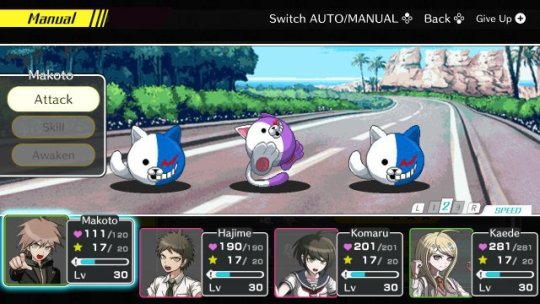
— I wonder how they’re fusing the turn-based combat into the board game this time? Obviously there shouldn’t be some random “exams” that occur at the end of a board, because the story is no longer centered around completing years of school. So what’ll be the driver behind encountering enemies? Maybe they’ll be on random board spaces?
— They showed us the screen where you can choose higher-level cards that represent more powerful versions of the game characters just like in Ultimate Talent Development Plan. But the main reason to use those rare-unlock options in UTDP was to get tougher characters for use in the Despair Dungeon. I’m not expecting a dungeon crawler to be included with this one, so what’s the purpose of the S-level cards and such? ........ Unless I really should expect dungeon crawling to be integrated into this somehow! I’m just spitballing now, but maybe we will progress through various boards, and some boards will represent dungeons/combat areas?
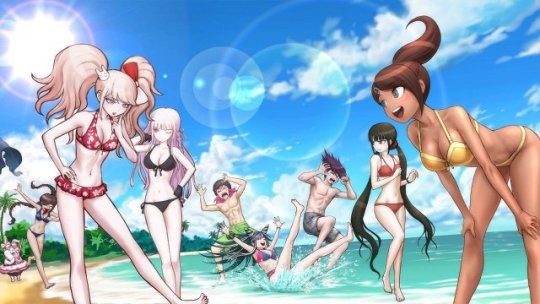
— Of course I assume Junko is behind the invasion of Monokuma and his army of Mono-bots. I’m quite confident that this is going to be another AU where she has a whole new plot for driving despair just like she did in UTDP/Despair Dungeon. Perhaps the entire resort trip is part of her overarching plan. We’ve already seen Junko (on the title screen) and “Junkuro” (seen above) in the screenshots so far, too, so Mukuro is presumably acting as support for Junko’s plot once more. And I wouldn’t be surprised if Tsumugi is in on the plot again as well... even though I’ve long wanted to see a version of Tsumugi who isn’t just evil. I was actually disappointed when I unlocked the scene in UTDP that revealed she was still putting on a front to hide her true nature.
— The prescence of “Junkuro” strongly implies that we won’t once AGAIN won’t get to see Mukuro as herself. :( That was one of the big disappointments of UTDP for me, although I realized at the time that UTDP was mostly made out of existing assets. However, now that they’re making a bunch of new sprites and CGs for Danganronpa S, it makes the idea of trapping Mukuro in her disguise just much harder to swallow... I hope I’m wrong and we can unlock some way to play as Mukuro as herself. UTDP at least gave us a retro sprite for her, but it doesn’t seem like it’d be that difficult to give her a proper sprite set.
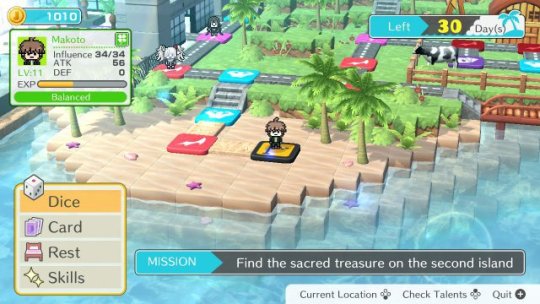
— What can we glean about the gameplay from the above screenshot? What drove the player to wander into a dead end of the board? Will such dead ends potentially hide some special items, rare events, or secret pathways? Is the player’s choice to venture down there somehow connected to the “Mission” stated at the bottom? Are these “missions” going to be side objectives or the main requirements to progress? It’s also noteworthy that every image/video of the board we’ve been given shows the same section of the same board. Is there only going to be one massive board for each runthrough, or will we still see different board options/”courses”? I hope for the latter, but I could do without the Despair Course...
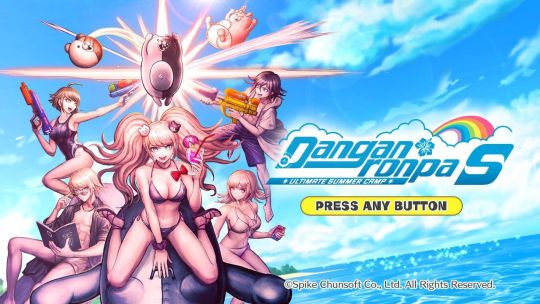
— Dude, I was shocked to see that Togami is ripped on the title screen. Still, I guess it’s believable enough that he’d take the time to sculpt his body as much as possible. I was much MORE shocked to see Kazuichi looking fucking CUT in the swimsuit scene. What the hell?! How many abs can you develop from mechanic work? Because I am assuming none. I guess he must work a lot of crunches into his days.
— Remember the “Future Course” in UTDP? It took a ton of time to unlock it, but I loved that there was a way to bring in the Danganronpa 3 anime-only characters, even if it was just for simplistic retro-style sprite interactions. I wonder if we’ll see anything similar with those characters in this release? They already have the retro sprites, after all! So here’s hoping for more time with the Future Foundation crew.
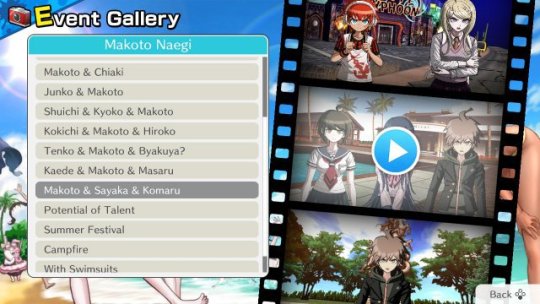
— Really digging the fact that you now unlock story/interaction scenes on a menu where you can rewatch them. That’s going to make the scenes I’ve experienced so much easier to track! I’d really like to see them provide some hints for any spaces on the menu that are unfilled, but I won’t hold my breath.
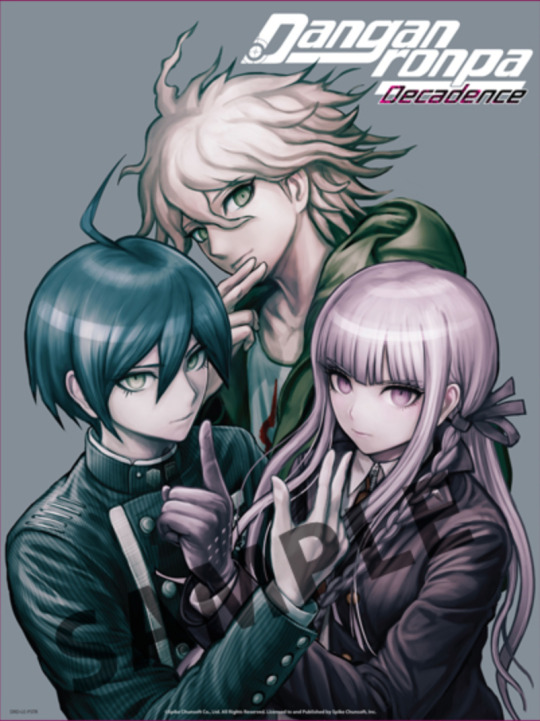
— The selection of characters featured in the Collector’s Edition art print is sort of random, isn’t it? When you take all three together, is there any commonality they share? This feels like the result of some Japanese fan poll that determined these to be the most beloved/marketable options or somesuch.
#danganronpa s#happy danganronpa s#danganronpa s: ultimate summer camp#danganronpa screenshots#danganronpa#dr1 spoilers#drv3 spoilers
165 notes
·
View notes
Text
Ziplines, Blood Ties, and Colonavirus — Thoughts on: The Silent Spy (SPY)
Previous Metas: SCK/SCK2, STFD, MHM, TRT, FIN, SSH, DOG, CAR, DDI, SHA, CUR, CLK, TRN, DAN, CRE, ICE, CRY, VEN, HAU, RAN, WAC, TOT, SAW, CAP, ASH, TMB, DED, GTH
Hello and welcome to a Nancy Drew meta series! 30 metas, 30 Nancy Drew Games that I’m comfortable with doing meta about. Hot takes, cold takes, and just Takes will abound, but one thing’s for sure: they’ll all be longer than I mean them to be.
Each meta will have different distinct sections: an Introduction, an exploration of the Title, an explanation of the Mystery, a run-through of the Suspects. Then, I’ll tackle some of my favorite and least favorite things about the game, and finish it off with ideas on how to improve it.
If any game requires an extra section or two, they’ll be listed in the paragraph above, along with my list of previous metas.
These metas are not spoiler free, though I’ll list any games/media that they might spoil here: SPY; mentions of the “Nancy Games” (ASH-SPY); SAW; mention of National Treasure (2004).
The Intro:
It’s our penultimate meta, and this time, it’s personal.
In every way, The Silent Spy is the culmination of the Nancy Games. Ever since her trip back home in ASH, Nancy has been increasingly featured in the games, showing us more of her personality, her life, and her backstory — all in an effort to lead up to this story, where we actually delve into Nancy’s place in the world and what it means that she lives in it.
And the answer to that is a lot less wholly idealistic than the franchise would have given 20+ games ago.
I don’t mean to say that SPY is a cynical game — it’s honestly fairly neutral, edging on positive — but that SPY accepts the fundamental truth that all of the Nancy games have been leading up to: that Nancy, though talented, hardworking, and connected, is simply another fish when it comes to the sea of life. She’s not unique in any way that really matters – look at her foils in Alexei, in Jamila, in Deirdre, in Jessalyn — and yet she continues to work hard, to solve puzzles, and to right old wrongs.
At least for me, this is a hopeful message. The point of “Nancy Drew, Girl Detective” is not that no one could do what she does, it’s not that she’s the best, most experienced sleuth in the world, and it’s not that she’s the Last, Best Hope of those who call upon her for aid. The point behind her character is that she’s a relatively normal (if wealthy) girl who does what she can, and chooses to do it again and again.
There’s a wonderful part in the equally wonderful movie National Treasure when our heroes are reading a part of the Declaration — the part talking about the right of the citizens to throw off a despotic government like the British had become — and Ben (Nicholas Cage, actually in a good movie for once!) defines it in modern speech:
“If there’s something wrong, those who have the ability to take action have the responsibility to take action.”
In the beginning of the Nancy Drew games series, Nancy is merely an intuitive puzzle solver. She gets her cases through family connections, turns up at places where mysteries happen to occur, etc. etc. As time goes on and she practices, she eventually comes to the point where she’s being hired for bigger and bigger cases, more and more regularly — in short, she starts to live the truth of that quote. Nancy is, at her core, someone with the ability to take action against things that are Wrong. Throughout this series — and most especially, throughout the “Nancy” games (ASH-SPY), she becomes someone who recognizes her responsibility to take action.
And that’s what’s showcased here in SPY. Upon arriving and learning that she’s been led to Glasgow under false circumstances, Nancy is immediately and wholly over her head — but she’s still someone who has the ability to take action to right a wrong. When she’s working against Revenant, warning the scientist, or reading through secret memo after secret memo, she’s not doing it with the intent to Save the World; she’s finishing Kate Drew’s last task. Her loyalty isn’t to Glasgow, to Cathedral, to MI5, or any other player in this story — her loyalty is to her mother, and to the task Kate Drew died while trying to finish.
Which is, in my view, the best possible motivation in a game that’s all about family.
With that discussion behind us, I want to talk a little bit here about the other theme of this game — power. Revenant, as the terrorist group that they are, want to seize power; their goal is to run Glasgow (branching off from there into a wider sphere, of course) through seizing power during a (self-induced) state of emergency — aka, what’s referred to in-game as the Colony operation.
This is, of course, Politics 101 — whip people up into a frenzy, come in promising to Save Everyone, and entrench yourself in power that you can’t be moved from with any amount of ease. And while Revenant planned it for 2005, it would work even better in 2013, when social media and instant, 24-hour news cycles can keep the fear alive far more effectively than Revenant would have hoped for nearly a decade prior.
Both in 2005 and 2013, Revenant nearly succeeds, only to be foiled by a red-head out of her depth but who tries anyway (the difference between the two, of course, is that Kate was isolated and Nancy had backup). The most startling thing — and one of my favorite things about this game – is that it doesn’t end with Nancy ‘killing’ Revenant once and for all, or even stopping the Colony Operation once and for all. Nancy is, in every way, out of her depth here; she’s not used by either side as an agent, or even as an asset — she is, as Zoe reminds her, a tool, valuable for what she might know, not for her skills, not for who she is, or what she works for.
As the games from TOT on have worked hard to expand Nancy’s world and tie it together, SPY shows the benefit of having a wide-open world: that the world goes on, people live and die, and secretive organizations (ATAC, Revenant, Cathedral, MI5…) plot and scheme to remake the world in their image.
This, in my view, is also a great thing. The thing that Nancy Drew books (and a lot of the early games) get wrong is that Nancy fixes (or is party to fixing) all of the problems introduced. The piano-playing girl that Nancy meets ends up with a Grandmaster as a teacher; the inheritance goes to the Worthy Widow and Her Daughter; Nancy rescues her tied-up father AND solves his case for his client all in one brilliant masterstroke.
That’s not to say that every story should have all of its threads dangling by the end, but Nancy is simply a smart and resourceful girl, working (most of the time) with her own relatively meager resources. She shouldn’t be the answer to the world’s problems, and I think it’s lovely that, especially in the Nancy games, she really isn’t. Nancy is a helper, and that’s far more valuable than being an omniscient, all-powerful being who can magically fix everyone’s problems just by being there.
The last thing I want to talk about in this introduction is how good SPY is for Nancy’s own personal lore. There’s a lot of fuss every time SPY is brought up about how “Nancy’s mom actually died when she was three!!” which, honestly, tells me that the 60s re-writes (which, yes, if you’re pedantic, started in ’59) did more damage than I had previously thought.
The original Nancy Drew books were written in the 30s by various ghostwriters, and were a little different from the yellow-bound 60s rewrites that most people consider the “old Nancy Drew books”. 30s Nancy Drew was a little closer to our games-universe Nancy; brash, outspoken, punishingly independent, and incredibly capable. She’s also a bit violent and unruly, has graduated from school at 16, lost her mother at 10, and does as she pleases with the occasional call home to reassure Carson or (more often) to ask a question about the law.
Sadly, other than taking out a few racial and societal overtones that weren’t really acceptable after 30 years — mostly by taking out any non-white characters and including different forms of bias, note — the yellow rewrites weren’t an improvement to the stories or to Nancy’s character. Nancy becomes less bold, less independent, and far more focused on describing each meal in punishing amounts of detail. The words “kindly” and “sweetly” were increasingly added after “Nancy said”, she’s far more deferential to authority, and her mother instead passes when Nancy is 3, rather than 10.
In changing the form of the media to video games, rather than books, what would eventually become HER had a choice; they could align themselves with the newest Nancy Drew books — the Nancy Drew Files and Nancy Drew on Campus, both of which were known for being Hotter and Sexier (and, in the case of Campus, ridiculously stupid) — or choose what people called “the classics” — the yellow-spine 60s rewrites, as the once-famous blue books had been all but forgotten in the 90s. In the first (and still one of the last, honestly) brilliant move of the series, HER chose to mix and match the things that made for good game fodder from (nearly, given how much the Campus books suck) every written incarnation of Nancy.
And, to their credit, they chose an important fact from the 30s: Nancy’s mother died when she was 10, not when she was 3.
Losing a parent is a defining moment no matter when it happens, but the exact effect often changes based on (among other things) the age of the child. In order for Nancy to be the kind of person who is influenced by the mystery of her mother’s death, her mother had to have died when Nancy could remember — thus, 3 is right out, as Nancy might remember tiny bits and pieces of the events leading up to and right after, but nothing else.
By taking bits and pieces of contrasting (and often contradictory) lore and making their own out of it, HER (and I’m hat-tipping Cathy and Nik especially here, given Nancy’s characterization spike beginning around WAC/TOT) gives us a version of Nancy that’s similar to the sleuth we know and love from the books and movies (ignoring the 2007 disaster) and, occasionally, TV shows, while still keeping her mostly consistent and showing us a few new flashes that make this character stand out and win her place in the Drewniverse.
Now, with all of that said, let’s move on to this game in specific, shall we?
The Title:
The Silent Spy, as a title, is one that is wonderfully mysterious and really makes you want to know more — right up until the title drop within the game itself, at which point it shifts from quite alluring to desperately sad and foreboding.
After all, “the only silent spy is a dead spy.”
As the game really is about our resident Silent Spy — Kate Drew and her actions and legacy — this is really the only title that the game could have had, and it suits it down to the ground, both with its mystery and with its sadness.
In life, Kate Drew was silenced, and in death, she is obviously necessarily silent — but Nancy reads her words, remembers her speech, listens to her voice, and, of course, hears her song, whenever the world is quiet enough. And I think that’s a wonderful dichotomy for the title to introduce before the game has even properly begun.
The Mystery:
Summoned to Scotland by a mysterious message and guided by a photograph of her mother, Nancy arrives ready to retrace her mother’s steps — only to be thrown into a world of espionage, gadgets, untraceable phone calls, and deadly mishaps. Her luggage (and her best clue about her mother) having been stolen, the presence of an old family friend who refuses to talk, an evasive skiptracer, an excitable local, and a clever intelligence agent all work together to ensure that Nancy is off-balance the minute she arrives.
All, of course, is even less what it seems than Nancy is prepared for, and she spends to game gloriously off-balance trying to keep up with the larger forces pushing and pulling her. She needs to retrace her mother’s steps, escape from certain death, dig deep into the pasts and presents of the people she meets, and do some impressive sleuthing of her own to even make the change from tool to player — and even that might not be enough to keep her safe when the dastardly minds at Revenant come a-knocking…
As a mystery — or as a collection of intertwined mysteries, honestly — SPY succeeds at what a lot of other games tried (and ultimately failed, in one way or another), which is to link all the happenings in the game together under one cohesive plot that grows more and more horrifying the more you think about it. GTH has a fandom reputation for fridge horror, but SPY holds its own easily when you consider Kate’s fatal chase, Moira’s abduction and guilt, the threats that Ewan and Alec operate under, and the life that Zoe leads on the regular.
Every action that Nancy takes benefits someone — whether it be Cathedral, Revenant, herself, or an interested third (fourth?) party — without her really meaning to, and the game is great in including another question in every reveal.
The beauty of SPY’s mystery(s) is that it takes careful reading, paying attention, and honestly replaying in order to grasp the enormity of every action. No matter how many times you play or replay, there’s something new to find — a time-sensitive conversation, an implication in a note, a theory behind the presence of a clue or a piece of (what you previously thought to be) set dressing — it honestly is limitless, and it just helps to contribute to the feeling that this is a world that Nancy isn’t meant to truly be fully immersed in.
And speaking of people who are immersed in that world…
The Suspects:
We’ll begin, for organization’s sake, with our out-and-out (current) agents first, then tackle our other suspects, then our Nancy-related people, and finish off with — for the final time in this series, as this is the last “Nancy” game — Nancy herself.
A new, yet returning character, Bridget Shaw is one of the cover identities of Zoe Wolfe — aka Samantha Quick, who Nancy impersonated in VEN and who helped the Hardy Boys in Treasure on the Tracks.
Prior to SPY, I had money for a very long time that Samantha Quick would eventually come into the game, and I was absolutely delighted with her appearance in SPY — where else would she be so well situated? Zoe is snarky, disillusioned, cynical, and sometimes downright nihilistic, but she’s also someone who took up a job that, percentage-wise, no one wants to or is able to do, because she’s alone:
“I work in the field for two reasons: one, I don’t need any help. And two, because no one would miss me if I fell off the grid.”
I love watching the ND games subvert their own formula, and Zoe is a great example of the “helper”-type suspect who really isn’t like your traditional “helper” at all. She’s there to do a job, and if sticking with Nancy helps her to do it, then that’s what she does. But she’s not there to Right some Great Wrong for the warm fuzzies of it all, or even because it’s Just and Right. She’s there because it’s her job, and her job is to play the game.
“It’ll be brief, painful, and full of garbage…but that’s life, isn’t it? And that’s the metaphor I’m riding into the grave.”
Next is our (kind of) double operative and partial culprit, Ewan McLeod (real name Sean Kent Davis) is a clever operative of Cathedral who decided that he wasn’t valued or important anywhere near as much as he should have been, and reached out to Revenant to supply them with information. Summoning Nancy to Scotland, Ewan is easily able to gain a portion of her trust as the Watcher in the Wires and is her tie to the relative safety of Cathedral.
As a culprit, Ewan is — ultimately — pitiable. Not that he’s not an egotist with a victim complex a mile wide, but when you actually look at the situation he’s in, it’s hard not to feel bad for him, even though he did it to himself. Having contacted Revenant, he’s now attempting to hold a tiger by the tail, praying it can’t eat him — and his worst fears come true, as his loved ones are threatened (“trying to keep my friends and family alive”, remember) and he’s discarded and made a target by the terrorists that he tried to use to make himself important.
Given the rather chilling threats made by Revenant, I’m inclined to believe that when we find him tied up, he didn’t do it to himself. Nancy would have noticed if the knots were too loose to have been done by a third party, and we know Revenant told him several times that if he wasn’t useful, he’d be punished.
While Ewan makes terrible choices, he’s also a pawn being played by a larger force — like everyone else in the game — and that is at least worth pity, if not forgiveness.
Next up is our former Cathedral agent and all-around tough cookie Moira Chisholm. As one of the people responsible for the events that led to Kate’s death — though no one but Revenant is responsible for killing her, note — Moira lives with guilt, regret, and a powerful sense of loneliness that only the loss of everyone you hold dear can bring.
Moira’s guilty of nothing in the present-day calamity, and helps Nancy the very best she can in her own limited power, but is ultimately a character for whom the past looms larger than the present can match. She has her hobbies, but her house is filled with memories of days when people sat on her couch and broke her teacups, not of hours reading alone.
She’s an intensely tragic character, and an example of what happens when your need to know the “truth” can get in the way of doing right by those you love. Moira lost everything to her previous job for Cathedral (who is implied to have left her, an otherwise dangerous free agent, alive because they knew (correctly!) she would become stagnant and docile under the weight of her own guilt, ouch), and yet she risks life and limb to help Nancy —not because she thinks it’ll exculpate her, but because Moira, at her core, wants to help the world, no matter what it’s taken from her.
Our final suspect is Glasgow’s resident skiptracer and unwilling pawn Alec Fell, who, along with Moira, can be traced back to Kate Drew’s death. Originally, Alec investigated a mysterious car crash — the one that killed Kate Drew — and, when he didn’t stop after a warning, had his office ransacked and burned. In the few months before the game starts, he experiences another break-in and his sister is kidnapped, with a message informing him that if he wants to guarantee her safety, to comply with Revenant’s orders.
Unlike Ewan, when pushed into a corner, Alec does his best to raise a little hell while still trying to keep his sister safe. For everything that he does on Revenant’s orders, he also helps Nancy out, finds her suitcase, locates Moira, tells Nancy where the cards are, and does his best to push back in other, little ways.
Sure Alec is guilty of a few things — most notably the fake shooting scare in Nancy’s room — but he’s a very active character, riding the rails and searching for anyone who can help put an end to this situation. It’s not for nothing that he’s a fan favorite, both for this game for the series at large, and his excellent VA and charming dialogue only make up half of his appeal.
On our Nancy side, we’ve got a few returning characters and one (semi) new one, so let’s go through them before getting (for the last time!) to the girl detective herself.
Carson Drew, father and golf model extraordinaire, is here to ground (as in steady, not punish) Nancy as she goes through this mystery. As the other person besides Nancy who was most affected by Kate’s death, Carson is an invaluable source of Kate-related knowledge, but is concerned foremost with his daughter’s safety.
For my money, the most important thing we learn about Carson here is that, well…he married the wrong woman as much as Kate married the wrong man. It’s sort of simplistic to say that their story shows that, in some cases, love doesn’t conquer all, but it’s true all the same.
Carson was happy to jet off to Scotland on occasion to visit Moira and her husband, but being happy to take vacations is a very different thing from a life constantly shifting and changing. He’s a prosecutor, so he has a strong sense of justice, but also has a strong sense of stability — he chose a career with a set trajectory and clearly defined rules.
Kate Austin, however, was a journalist who occasionally consulted for a Spy Organization when life got a little too boring (it’s important to note that she wasn’t a straight-out spy like Moira — she was far too free-spirited for that). She had all of Nancy’s inquisitiveness but more people skills than Nancy will probably ever have, and made friends easily.
It’s easy to see how she would have been attracted to the All-American, hardworking, solidly intelligent, emotionally balanced man, just as it’s easy to see how the slightly flashy, clever, inquisitive, intuitive redhead would have attracted him.
If this is starting to feel like I’m describing two other characters here…well, longtime readers of this meta series already know what happens when I use a paragraph to describe characters without using their names.
Kate is important in the game in that we’re shown her differences from and —more enlightening — similarities to Nancy. Nancy’s actions in this game are reflections on what Kate did (and what she would have done) as much as they show how the daughter diverges from the mother. And while Nancy doesn’t have her mother’s people skills or ease of making friendships, what she does have is her mother’s – and I’m going to use this word purposely — flightiness.
At the end of the day, Carson couldn’t be with Kate when she flitted off around the world, and Ned can’t be with Nancy when she does the same.
(I also find it interesting that we deal in the games only with Carson’s side of the family, and never even have a mention of Nancy’s maternal grandparents. Yes, I know Kate could have been an only child and her parents could already be dead…but I do like the possibility that they blame Carson for Kate’s death (entirely undeservedly!) and thus cut off contact. But this meta is for, well, meta, not fanfic.)
Ned Nickerson plays an important role in SPY in that he tries to help Nancy the best he can, even to the point of breaking and entering in her house (though really, it’s just entering, since he has permission) to find a document for her.
Ned comes off brilliantly in this game, but it’s important to note that his big, impressive (yet charmingly understated) speech isn’t to Nancy, but to Carson. And it doesn’t sway Nancy, it sways Carson. Because, at the end of the day, Carson can relate to lots of the pieces that make Ned what he is, and the situation that Ned finds himself in.
He’s wonderful, as boyfriends go; he calls her, encourages her, offers oddly prescient hints…but he doesn’t go with her. It’d be easy enough to make that a point in the series that, though we don’t see it happen, Ned often accompanies Nancy on her escapades, but instead we’re told — often through contention — that the exact opposite is true.
Ned is solid, true, intelligent, emotionally balanced and kind, but above all, Ned is stable. He’s enrolled in college — in an honors frat — and plays sports, attends his classes faithfully, remembers important dates…the list goes on and on. These are all wonderful characteristics for a boyfriend, but he, like Carson with Kate, ultimately isn’t what Nancy needs out of a relationship — and she is certainly not, like Kate with Carson, what Ned needs out of a relationship.
At the end of the day, both would need to compromise — Ned would need to set off with her sometimes, and Nancy would need to stay close to home sometimes — in order to make the other happy. And, well…nothing we have in any of the games says that either one would do that in the long term. Sure, Nancy returns home after the fight in CAP for ASH…but is in Egypt the very next game — immediately followed by Colorado, Georgia, and Scotland.
And honestly, this is the basis on which I disagree with Ned/Nancy as a couple. It serves neither one and, as we see in quite a few games where they squabble, they can make each other worse.
And speaking of our resident sleuth, let’s talk about Nancy Drew before wrapping up this character section.
In SPY, Nancy is — as mentioned above — a tool, used by both sides to get what they want without caring how it personally affects her. The big thing we learn about Nancy in this — and one of my favorite characteristics about her — is that Nancy is pretty ruthless. To me, it makes sense that, to get the information she wants, Nancy does what a terrorist organization tells her to because 1) it’s not her home immediately at risk, and 2) most importantly, Nancy has done bad things in the name of a good end in pretty much every game.
Lying, stealing, breaking priceless artifacts, endangering others — none of these are really new to Nancy, and what SPY does is brings that to the forefront. Sure, you as the player have the option not to do what Revenant tells Nancy to do…but then you miss out on big parts of Kate’s characterization — and, more importantly, a big part of Nancy’s.
In an unprecedented move, I’m going to reference National Treasure again, and quote part of Ben’s speech before he steals the Declaration:
“[A toast] to high treason…here’s to men who did what was considered wrong, in order to do what they thought was right — what they knew was right.”
To me, that shows us why Nancy does what she does — in SPY, and in every other game where she lies, cheats, and steals her way to the truth. She does it because, at the end of the day, Nancy is a person who is ruthless in her pursuit of her goal. And that’s a valuable trait.
Especially when one is dealing with spies, terrorists, and shady government operatives.
The Favorite:
I love most of SPY, so I’ll stick here with the things that especially stick out to me.
As covered above, I love: what this game does for the lore of the ND world; ‘Samantha Quick’; the many motivations of our suspects, and the emotional resonance that this game has.
Beyond that, there are a lot of little things. I absolutely love that they got the relative of the guy who plays Carson to play Nancy when she was little — that’s adorable to me. I love the cookie-making minigame, the outfit swap for Bridget/Zoe, the voice work for all of our suspects and helpers, and the beautiful locations (especially the spy cabin, both exterior and interior).
My favorite moment in the game is a sad one, but I’m a mercurial kind of person, so you should have really expected that. It’s actually Moira’s log/diary/letter to Kate (it functions as all three) after Cathedral deactivates her as an agent. I love a lot about it — the sad, almost desperate feeling to the words, the pen color changing as the seasons do — but nothing is better done than Moira’s last entry:
“It’s winter. It doesn’t matter that it’s winter, does it?”
My favorite puzzle is probably the zip-lining one. Sure, it’s easy, and sure, the animation makes me a little motion-sick, but it’s just….zip lines are just cool. That’s all there is to it. It appeals to the spy-loving idiot in me, and I think big-woosh-go-fast is stupid cool.
I also have to give a hat-tip to Kate’s letter — turning a fandom meme into a heartwarming story? Nik, you mad genius — and Nancy’s letter to Kate at the end. Both are beautifully written and are the perfect centerpiece to their respective characters, and both always put a smile on my face (and, at times, a tear in my eye) when reading them.
The last thing I really do have to mention here is Logan’s quasi-reappearance. I mentioned this in my “Top 5 Surprising Moments” meta, but I love, love, love that Logan is a Cathedral operative, and that he reported on Nancy during SAW. Not only does this continue to open up Nancy’s world, but it also shows that there are consequences to Nancy’s actions. She’s in rare form as far as rudeness goes in SAW, and SPY weaponizes that against her, giving Cathedral (and Revenant) a way to weaponize her feelings about her mother’s death and her — to be frank — inability to let things lie as they are.
The Un-Favorite:
There are a few things that aren’t quite my favorite in SPY, so let’s run through those as well.
First, in the common refrain of “small visual distinctions are difficult for me personally”, I didn’t like that there wasn’t enough contrast between a plain (on the bottom half) cookie and the orange/purple jelly. The shadow on the screen makes it kind of difficult to tell them apart, especially if there’s sprinkles and/or frosting on top of it, and I found that mildly frustrating, even though I love the minigame itself.
The second thing I don’t like is the option to skip the dialogue. Yes, this is present in most of the newer games, and I don’t like it in them either, but it’s especially egregious in SPY and LIE. Both of these games really rely on hints given in the dialogue (and of course, in the written materials hidden around the game) in order to get a full, clear view of what’s going on. The option is great on repeat plays, but I really do wish that it was disabled if it was your first save file on the game.
The last annoying thing is the Jabberwocky puzzle — or rather, the percentage of the jabberwocky puzzle that the player actually has to do. The puzzle as it stands feels very confusing, and the “hints” you get are quite unintuitive.
The record tells you basically how to create the encrypted message — it’s the first letter from each green word, the second from each orange word, etc., arranged in the order they appear in the poem — but when you start the poem, Nancy has already basically completed this step, and it’s up to you to do the actual decoding just through process of elimination.
It’s a puzzle of letter deduction, like in TMB and the minigame in ASH — and these are normally my favorite puzzles! — but it’s cloaked in the disguise of an encryption puzzle, and for that, it’s incredibly irritating.
The Fix:
So how would I fix The Silent Spy?
The first thing I’d do, which you can probably guess based on the above section, is to fix how the Jabberwocky poem is presented. Even a bit of dialogue establishing what the player actually has to do versus what Nancy does for the player would be helpful in working through it without bothering making the encrypted message oneself, and would set the player up to actually know what they’re doing, versus the mass of confusion that comes with the puzzle.
The only other change I would make would to put in one more flashback — that of 10-year-old Nancy’s perspective shortly after Kate’s death, perhaps after the funeral. We spend a lot of time in flashback seeing Kate before her death, and I think it would add to just a little bit more of seeing Nancy’s relationship with her mother if we could see the Drew house with her recently gone.
(And perhaps, see or hear Hannah? Please?)
The Silent Spy is a game that I find, on the whole, to be one of the best that Nik penned, and certainly a fitting end to the series of “Nancy Games” that gives us a little more perspective on our teeth sleuth. There are as many moments of joy as of sorrow, but in the end the player is left with the feeling that Nancy’s world is a little better for knowing more about her mother, and that whatever else Kate did and was, she left behind a world (both in game and breaking the fourth wall) that was better — and had ways to become even better than that — than it was when she lived in it.
#nancy drew#nancy drew games#clue crew#the silent spy#nancy drew meta#SPY#video games#my meta#long post
19 notes
·
View notes
Text
Feel-good “bad ends”
Movie protagonists are often breaking the rules. This is true even when our protagonists are on the right side of the law: after all, nobody’s perfect. (And if they were, we probably wouldn’t like them as much: after all, it’s hard for a character to have a “growth arc” if they start from a place of perfection. And making occasional mistakes reminds us that, just like us, they’re only human: they’re more relatable.)
But when our protagonists break the rules, it often leads toward one of two different endings: either they get caught and punished for their transgressions (which can make for a feelbad ending), or they get away with it scot-free. Most movies opt for the latter, but it can often feel unsatisfying, because there’s a real sense in which we want to see our protagonists reap the consequences of their actions.
Usually, it’s not a problem for them to suffer the consequences if their transgression is minor. For example, if the main character says something mean to his love interest, he can get a slap in the face -- and having paid for his transgressions, he can then immediately be rewarded with whatever feel-good conclusion the audience is in the mood for.
However, sometimes the protagonist’s transgressions are more dire, and demand more dire consequences. Recently, I’ve found two movies that manage to end with something that is, in an objective sense, a very bad outcome for the main characters, and exactly in proportion to what they deserve for their significant transgressions during the film, yet still allows for a “feel-good” ending. Naming those examples would by itself probably be a spoiler, so...spoilers for an Edgar Wright movie and a Pixar movie (and a Rocky movie) below the fold.
Heist movies are the classic example of a movie formula where the protagonists break a ton of rules and, in the case of a feelgood ending, basically can’t suffer any consequences. Either they get caught and it’s a moral aesop about how crime doesn’t pay, or they get away with it and we’re happy that our characters, who are really quite morally virtuous apart from their tendency to commit acts of robbery, are able to enjoy the spoils they’ve absconded with.
Baby Driver is a movie that I think strikes the perfect balance. In the end, our main character Baby doesn’t get away with his crimes. He’s committed a lot of crimes, and been involved in a lot of robberies. And not the non-violent kind, either!
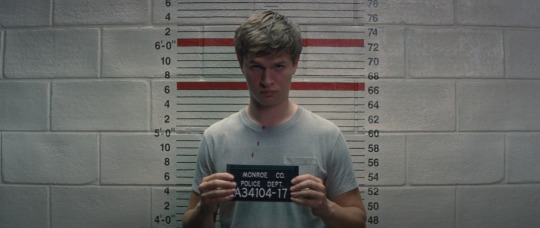
At the same time, Baby was always “one of the good ones.” He was never the guy who held the gun; he was always the one behind the wheel. In fact, for basically his entire criminal career, he was blackmailed into it. Of course, the lazy method would be for the judge to have pity on him -- he was forced to commit crimes! But that would be ignoring the fact that the entire reason he got blackmailed in the first place is that he happened to steal a car from a criminal kingpin -- Baby was boosting cars well before a villain put a gun to his head and forced him to do it.
But as we see Baby marched to his prison cell, it’s intercut with testimony during his trial. Everything that we could have said in Baby’s defense is articulated by witnesses speaking in his defense:
“He got himself into a bad spot. I was just trying to get him out. I believe the defendant is of good character. He didn't deserve what happened to him.”
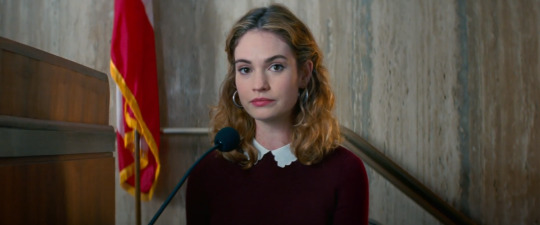
“It was the strangest thing. Before he drove off, he threw my purse right at me. Then he actually said ‘I'm sorry.’” (A delightful callback to a comedic moment earlier in the movie: Baby might resort to carjacking when he’s in a pinch, but he is the most polite carjacker you will ever meet. He doesn’t need your valuables; he just needs a getaway vehicle.)

“He made a mistake when he was younger, and it's haunted him ever since. When he tried to get out, he was pressured even harder. It was never his fault. He's got a good heart. Always has. Always will.”
Maybe it’s the fact that Sky Ferreira’s cover of Lionel Richie’s “Easy Like Sunday Morning” is the musical bed for this scene, but there’s something about the scene that feels incredibly cathartic. Baby Driver might be our protagonist, but he’s not innocent in all of this. His actions have consequences, and he gets sentenced to prison time for them.
At the same time, we’re left with the distinct impression that he has a life waiting for him on the outside. At the very least, Deborah is there waiting for him.
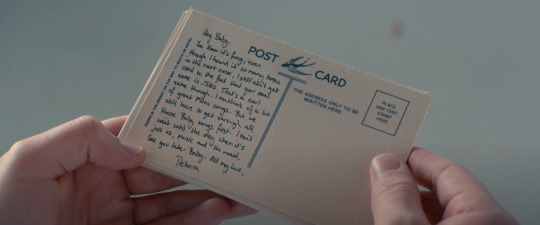
We can rest assured that Baby has no desire to return to a life of crime -- he and Deborah will be content with a modest life together. Indeed, a “modest life” is never something that either of them would need to settle for. Having a quiet simple life has been their aspiration for as long as they’ve known each other. Baby ends the movie knowing that he has years of prison time ahead of him, but also knowing that he’s on the start of a path to redemption. It’s enough to put a skip in his step as he walks across the prison yard. (Well, maybe not a literal skip in his step, but at the very least, it’s written on his face: he feels good about the path he’s on.)

Baby Driver came out in 2017, but I’ve already lost count of how many times I’ve watched it. I think the ending is a big part of what keeps me coming back to it. I love this ending -- there’s really nothing like the catharsis of seeing Baby held to account for his actions, while also having his virtues acknowledged. Those virtues might not be enough for him to avoid punishment, but in a way, his virtue its its own reward. It’s a heist movie that ends with the main character getting caught and spending years behind bars, and yet it’s an incredibly feelgood ending that just leaves you satisfied for all the right reasons. (After all, we’ve seen the fate of Baby’s confederates: we know that he could have encountered fates much worse than prison.) There’s really nothing like it.
Well, almost nothing. Last night I finally got around to watching Monsters University.
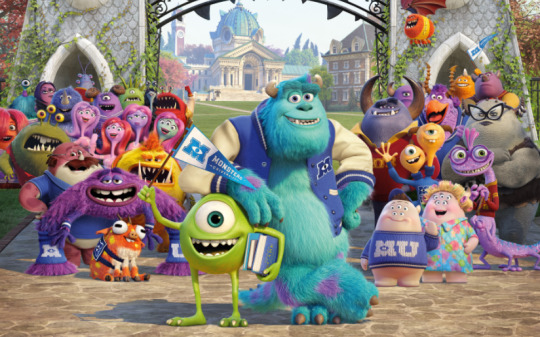
It’s a fun movie -- the central plot is the classic “underdog sports story.” Mike Wazowski has no talent for scaring -- according to the bigshot jock voiced by Nathan Fillion, the only way someone like Mike could end up working at a place like Monsters Inc is in the mailroom. Of course, because this is a prequel, we know that Mike’s story ends with him and Sulley being best buds together working at the Monsters Inc scream factory, so the odds can’t be that stacked against them, right? After all, the stakes are too high for them to fail: besides the fact that they need to be ready for the events of Monsters Inc, Mike is able to parley for a chance to get into the university’s scare program only because he makes an agreement with the Dean that if he fails, he’ll leave the school. With stakes that high, it seems only inevitable that Mike and Sulley will fulfill the classic underdog trope and lead a team of lovable losers to victory through sheer force of will (and the power of friendship).
Except, as we find out, force of will and the power of friendship aren’t enough to win you the big game when the thing you’re being tested on is talent and athleticism. Mike gets to experience the triumph of victory...but quickly learns that it only happened because Sulley cheated.
Mike and Sulley both bit off more than they could chew, and made a number of poor choices along the way. Sulley, unable to accept loss, cheated to achieve victory. Mike, unable to cope with experiencing loss, breaks into the university’s door department to mope around in the human world -- which is strictly verboten and extremely dangerous.
But...in the course of solving the problem that they’ve created themselves (combining their efforts to escape the human world by using scare techniques the likes of which have never been seen before), we learn that Mike and Sulley do have what it takes. The Dean recognizes it, too. It almost feels like she’s about to offer them leniency. After all, this is a prequel movie: we know that all of this has to end with Mike and Sulley working at Monsters Inc in the scare department, right? That means the Dean has to let them back into the university’s scare program! Surely their acts of daring and bravery show they have what it takes to make it in the Monsters University scare program!
And so it comes as no surprise when, at the end of the third act, the Dean comes out just as they’re about to depart. We see what looks like a smile on her face for the first time in the movie.

Except, of course, it would be crazy if they got off scot-free. Mike broke into the human world, which is about the worst possible thing a monster can do. And if the cheating scandal weren’t enough to sink Sulley, there’s also the fact that he followed Mike into the human world (his intentions were noble as he wanted to save his friend, but still extremely dangerous and just as verboten).
The Dean has nothing but kind things to say to them. But that doesn’t mean she’s going to rescue them from the consequences of their actions.
The two get no leniency. We feel an odd mixture of elation and defeat. On one hand, they got the validation that they craved: the Dean, who thought it was impossible for Mike Wazowski to ever be a scarer, now admits that she may have misjudged him. On the other hand, their lives are ruined. They must now reap what they have sown. What will become of their dreams now? And maybe more importantly, how the heck are we supposed to get from here to the events of the original movie that takes place several years later in the Monsters Inc chronology?
And then, Mike remembers something.
“You know, there is still one way we can work at a scare company. They’re always hiring in the mail room.”
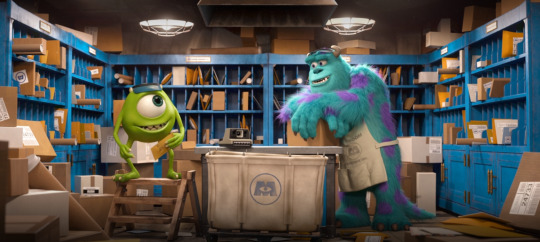
Mike and Sulley start at the absolute bottom rung of the corporate ladder. But there are worse fates than doing blue collar work. After all, the entire theme of the underdog sports story that got us to this point was to show that Mike (and, with Mike’s encouragement, also Sulley) are the kind of monsters who will do whatever it takes to achieve their dreams, simply willing it to happen through sheer enthusiasm and force of will and, of course, the power of friendship. After all, anything can be fun when you’re doing it with your friends. As Sulley says, “This is better than I ever imagined!” They approach the job with an enthusiasm that tells us that they’re on their way up within this company.
The rest of their journey is shown to us in montage:

They’ve got that ambition, baby. This week they’re mopping floors, next week it’s the fries:
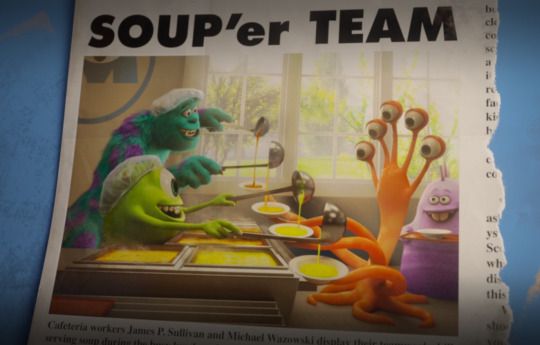
Of course, it’s only a matter of time before the company holds “try-outs” for the scare team, and from there, the rest is history. Plus, if the original movie is fresh enough in your mind, you’ll appreciate the easter egg references to the girlfriend that Mike met during this time (and the constant beratement he constantly got over needing to file his paperwork):
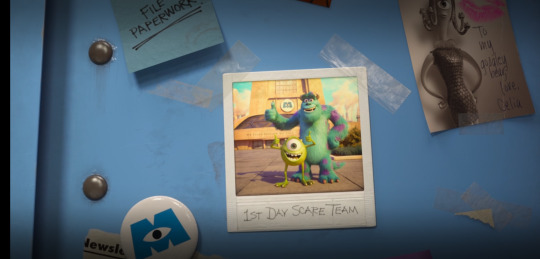
Over the course of the movie, they made some good decisions -- mostly the ones relating to the power of friendship and hard work. They also made some bad decisions -- mostly relating to playing fast-and-loose with the rules of their institution. Their college careers come to an unceremonious end.
And yet, even though the movie ends with them getting kicked out of college and spending “the best years of their lives” working blue collar jobs, it feels like an undeniably happy ending for the two of them. They reap exactly what they sow -- for worse, and for better. They don’t get to hide from the consequences of their actions...but that doesn’t mean things have to end on a dour note.
There’s something I really dig about that. It feels exactly like the first Rocky movie: Rocky is an athlete who trained and tried and fought as hard as he could -- and still lost. And yet, though he lost the big boxing match, there’s dignity in his loss. And in the end, he succeeded at the thing that really mattered.
In all three of these movies, it feels as though we as the audience are being set up for a specific happy ending. Of course Baby Driver has to end with the getaway driver getting away. Of course Monsters University has to end with Mike and Sulley graduating from the scare program. Of course Rocky has to end with our main character winning the big climactic boxing match. But in the end, we don’t get these “obvious” endings, because getting them wouldn’t really be a reflection of everything that led up to that point. And yet, we don’t walk away disappointed, because we somehow get something better. These characters may not get the “obvious” reward, the thing that they thought they wanted (and the thing that we, as the audience, thought that we wanted). But they get the things that really matter.
27 notes
·
View notes
Text

Getting Psyched - A The World Ends With You Retro Review
Genre: Adventure Subgenre: JRPG Developer: Square Enix, Jupiter Publisher: Square Enix Platform(s): DS Release Date: July 27th, 2007 Hours Played: 42 hours this playthrough
You’ve almost certainly heard of this game, especially if you’re into JRPGs. When a game advertises itself as being “from the team that made Kingdom Hearts,” I was sold instantly as a kid. One look at the game’s box art confirms that Tetsuya Nomura had a hand at this game with his distinctive bold art style. But the game itself was something that nobody at the time had predicted. The game has an urban fantasy story unlike much that had been told at the time. Furthermore, the game was made to push the DS to its limits and create a battle system that could only work on the DS’s two screens. Does this cult classic live up to the hype, or is it just a janky mess? Let’s find out.
Story
TWEWY opens by introducing our protagonist, an antisocial teen named Neku Sakuraba. Neku unexpectedly awakens in the iconic scramble crossing of Shibuya, Tokyo. To his surprise, the crowds seem to walk right through him, and a strange pin appears in his hand that allows him to read the thoughts of passersby. Neku quickly learns that he has been thrust into the Reapers’ Game, a seven-day death game where the Players are the recently deceased that must partner up to fight the Noise, hostile part-animal-part-tribal-graffiti creatures that seek to erase the Players. What’s more, each day Players must complete missions given to them by the Reapers within strict time limits while avoiding the reapers themselves. If they can make it to the end of the week, they might just be able to return to life.
Along the way, Neku will meet a chaotic cast of characters including Shiki, the headstrong seamstress who is eventually able to get Neku out of his angsty shell, Beat and Rhyme, a pair of street-smart siblings with heavy 2000’s skater vibes, Joshua, an abrasive, sarcastic, literal Christ figure who’s somehow a good guy? Or maybe he’s a bad guy? Or… maybe he’s a good guy again? On top of that, the Reapers themselves vary wildly from the contrasting duo of the laid-back Kariya and the high-strung Uzuki to the lone radical Minamimoto. The game does a good job of having a full roster of characters without overloading the player. Furthermore, while most characters seem wacky at first, they all have motivations and layers behind them that become clearer as you progress through the story.
Without spoiling anything, nothing is as it seems in the Reaper’s game, and multiple parties are vying for control for different reasons, meaning the whole thing feels like one big political intrigue story on top of an urban JRPG. Even on my most recent replay after having played the game countless times over the years, I was hungry to put the pieces together. While the main storyline mostly follows Neku’s perspective and doesn’t explain a lot of the behind-the-scenes interactions and motivations of the secondary characters, the game fortunately has a Secret Reports feature, which are written by a certain character who seems to know way more than they let on. These Secret Reports are near essential to understanding the game’s true story, and reveal whole layers to the plot and world that the main story doesn’t even touch on.
Needless to say, I loved the story of TWEWY. Everything feels perfectly crafted, leaving no loose ends, while still leaving the player wanting more. If anything I wanted to see more of Neku and his friends after the game’s conclusion just hanging out in real life.
Gameplay
TWEWY is a JRPG, but in the loosest sense possible. In the overworld, the player controls Neku, guiding him around the various streets of Shibuya on the touch screen or with the face buttons. Unlike in traditional RPGs, outside of story events the player must deliberately initiate combat with the Noise. By scanning their environment they can read the surface thoughts of passersby, but also reveal noise symbols in the environment. By tapping on these symbols, the player can queue up battles with the noise, and can even chain multiple battles together for back-to-back fights that multiply your drop rate.
In battle, Neku and his partner are sent to separate Zones, with Neku on the touch screen and his partner on the top screen. Neku fights the noise by activating the abilities of pins he has equipped, called Psychs. Each psych has its own activation method, from swiping on an enemy to tapping empty space, to scratching on the screen, to shouting into the microphone, and more. It’s up to the player to equip Neku with the best pins, though pins level up as they are used, becoming more powerful and sometimes evolving into even stronger pins.
On the top screen, Neku’s partner fights the noise by using the DS’s face buttons to move through a combo map and select certain finishers. By selecting the right finishers, you can charge your Sync gauge to perform a powerful special attack. Both characters share an HP gauge, damage to each character subtracting from each side. If you’re following along, that means the game expects you to control both Neku and his partner at the same time. This can be tricky for new players, but you quickly get used to it. Additionally, you can have your partner auto-fight with a customizable delay, meaning you technically don’t have to control your partner at all. However, if you really want to deal major damage and wipe the floor with the Noise on higher difficulties, you’ll want to master battling with both characters at once. When I first played the game in 2007, I found the parner battling to be too difficult to keep up with, but now that I’m older and more experienced, I find the combat to be incredibly deep and rewarding. Additionally, the game rewards back-and-forth control of Neku and his partner with the Light Puck mechanic. Essentially, when one character performs a combo finisher, the light puck is passed to the other character, and passed back when that character does a finisher. In this way, you can build up a damage multiplier based on how quickly you rally the light puck. This creates a natural back-and-forth flow of using Neku until his psychs discharge, then getting a few hits in with his partner, and so on.
My only complaint about battles is that in later fights on higher difficulty the Noise will attack so frequently on the partner’s zone that it’s difficult to get attacks off with them at all. Your partner has a limited block/dodge, but it only does so much and there’s often tons of Noise attacking at once. It’s not insurmountable, but it can be frustrating at times.
Outside of battle, the player must constantly keep up with a few things, food, swag, and difficulty. Both Neku and his partner can eat food and wear clothing purchased from many shops around Shibuya. Food offers an up-front bonus as well as a permanent stat increase once the food is digested by completing battles. However, you can only digest so many times per real-time day, meaning you have to prioritize high-calorie foods before smaller snacks. I found the digestion limit to be a bit too limiting. It can be removed in the post-game, but it still makes food hard to deal with for someone that is effectively bingeing the game.
Swag are articles of clothing that offer flat stat increases, but also have abilities that are unlocked by showing it to the right store clerk. Each clerk can unlock the abilities of specific clothing, and you can unlock more by buying enough stuff from them to fill up their Friendship Gauge. I thought it was fun to slowly make friends with each store clerk, and I felt bad that I couldn’t hang out with them or reciprocate some of their obvious advances, though I’m sure it’s assumed that Neku cherishes his friendships with them after the game’s conclusion. However, you can’t just equip any old piece of clothing to any character. Neku can’t just pull off a dress and cargo shorts right off the bat. Each piece of clothing has a Bravery rating, with characters whose bravery is below that rating being unable to wear the clothing. Fortunately, bravery increases as you level up, and can also be increased by eating food. By the end of the game, you’ll be able to have Neku and company wearing whatever clothing you want.
Lastly there’s Difficulty. The game has four main difficulty levels, being Easy, Normal, Hard, and Ultimate. You begin the game in Normal, but once you unlock a difficulty, you can change it on the fly from the pause menu. On easier difficulty enemies have less HP and deal less damage, but you get fewer XP and worse pins. The reverse is true on higher difficulties, with some of the best pins in the game being available exclusively as drops on Ultimate difficulty. To aid you in this, you can also change your level at any time. Unlike in a standard RPG where your level is immutable to the player aside from leveling up, in TWEWY you can freely choose your level from one to the highest level you have achieved. For each level below your max that you set your level, you get a multiplier for drops. This can be combined with the battle chaining multiplier to get ultra rare drops, some of which have less than 1% and even less than 0.1% drop chances normally. This gives the player an incentive to level up aside from just stat bonuses, and rewards players who go out of their way to engage in battles. As above, battles are largely optional, but it heavily behooves the player to battle as much as they can, not only because you get drops and experience, but increasing your level gives you more wiggle room for harder fights such as bosses.
There are tons more smaller features, but these are the main ones. I thoroughly enjoyed the vast depths of the game’s mechanics and found the difficulty settings to be really engaging and a novel approach to RPG player advancement while still affording accessibility. I was enthralled for multiple hours as I struggled to get the best gear, feed my team the best food, and equip the best pins to get as strong as possible. Until the very end of the postgame, it never felt like mindless grinding, as you can just breeze through the story on Easy if you really want to, but where would be the fun in that?
Presentation
TWEWY is probably best known for its vibrant and bold incredibly urban street-art-themed style, which shows in not only the art, but the UI, music, and writing. The character art is that hard-outlined and overdressed Nomura art style that fans of Final Fantasy and Kingdom Hearts have come to love, and the backgrounds are all vibrant and stylized to fit. The pixel art of the character sprites and Noise are all incredibly expressive, with Neku’s idle animation as he jams out to tunes on his headphones being one of my favorites.
The game’s music is unabashedly lyrical, covering a vast array of genres including JPop, Punk, and Hip-Hop, with many different styles of each. I loved almost every song in the game, though I found one of the overworld themes to be a bit grating at times. Other than that, the music is pretty great, and what’s even better is you can buy CDs of each of the game’s songs in the game to have your own personal sound test right from the menu, even going as far as to allow you to set the background music on the menu itself.
The game even has voice acting, though it’s limited mostly to battle quips and wordless expressions for cutscenes. I actually really enjoyed the voice acting and thought they nailed each character. I was honestly surprised at the audio quality the developers were able to pack into this game. The music was a very slight bit tinny through the DS’s audio chip as is to be expected, but barring that the vocals and voice overs were super clear and the instrumentation of the songs were well mixed.
Overall, the game’s presentation is about as good as it gets on the DS, giving even home console games a huge run for their money.
Conclusion
Honestly it’s hard to say anything bad at all about TWEWY. The game was a bit hard to approach at the time, but it’s aged magnificently. These days, I wouldn’t hesitate to say that it’s the best (at least non-Pokémon) game on the DS. Honestly though some might be turned off by the game’s quirks, I think TWEWY is a masterpiece that everyone with a DS should pick up and play. I can’t wait to see how the newly-released sequel stands up, but honestly the original is a tough act to follow.
Score: 10 / 10
4 notes
·
View notes
Text
Pokémon Sword & Shield Reviews are in! ⚔️ 🛡

Areajugones - Ramón Baylos
Score: 8.8 / 10
The new Game Freak game will please both newcomers and more experienced players because, although some sections of this new installment have received less polish, it still has attractive enough content for every trainer to find his place in the new region of Galar.
Gamespot - Kallie Plagge
Score: 90 / 100
In collecting, battling, and exploring, Sword and Shield cut out the bloat and focus on what makes these pillars of the Pokemon games so captivating in the first place. You're not held back by overly complicated back-end systems or hoops to jump through; from the outset, you can start wandering the Galar region, seeing its new Pokemon, and trying out its new battle strategies with very little in your way. This leaves you free to enjoy what Pokemon is all about, and that makes for an incredibly strong showing for the series' proper debut on Switch.
Gamesradar - Sam Loveridge
Score: 90 / 100
Gameplay tweaks and attention to detail make Pokemon Sword and Shield the most compelling Pokemon world to date!
EGM - Ray Carsillo
Score: 80 / 100
The first new-generation Pokémon game to release on a proper home console does not disappoint. New features like Dynamaxing and the Wild Area are fun additions that make the experience of becoming a Pokémon champion still feel fresh. It’s just a shame that Game Freak didn’t lean into the new features more than they did.
Nintendo Life - Alex Olney
Score: 8 / 10
Pokémon Sword and Shield succeded in bringing some new ideas to the table, but they also somewhat guilty of not pushing things far enough. What’s done right is done right, but what is done wrong feels like it’s come from a decade old design document. There are moments contained within that are best the series has ever been, but the joy is at times spoiled by contrasting moments that left us disappointed and did not match up to the rest of what these games can offer. What we’ve got here is an experience filled with highs and lows, from the unadulterated wonder and joy of seeing brand new Pokémon in a stadium full of cheering crowds, to the monotonous and dragging out dialogue we want to skip.
Ars Technica - Andrew Cunningham
Unscored
The short version of this review is that Sword and Shield are fun, good-looking Pokémon games with a solid story mode and some welcome changes to the game’s mechanics.
Daily Star - Dom Peppiatt
Score: 3 / 5 stars
Pokémon Sword and Shield are not bad games. But fun character arcs and inventive, creative designs of new ‘mon are often offset by poor pacing and restrictive world design.The world of Galar is charming, and is a Pokémon interpretation of Britain I’ve dreamed of since I was a kid, but between gating what Pokémon you can catch behind Gym Badges, some half-baked route/City designs and a modest amount of post-game content, Sword and Shield can only be called ‘good’ Pokémon games… not ‘great’ ones.
Eurogamer - Chris Tapsell
Unscored
Pokémon Sword and Shield add some brilliant new creatures, but like their gargantuan Dynamax forms, the games feel like a hollow projection.
Game Informer - Brian Shea
Score: 8.8 / 10
The compelling formula of simultaneously building your collections of monsters and gym badges has proven timeless, but the new additions and enhancements show Pokémon isn't done evolving.
GameSpot - Kallie Plagge
Score: 9 / 10
Pokemon Sword and Shield scale down the bloated elements of the series while improving what really matters, making for the best new generation in years.
GameXplain
Score: liked
Video Review - Quote not available
Gameblog - Julien Inverno
Score: 7 / 10
With these new games Pokémon, Game Freak proceeds as usual in the evolution of the series, small touches, all the more welcome this time they seem absolutely necessary today, like the boxes PC accessible everywhere. Without major disruption but with significant improvements, in terms of game comfort mainly, and while some will probably deplore the reduced number of Pokémon referenced base in the Pokédex Galar, new region that enjoys a care of atmosphere and staging undeniable, Pokémon remains faithful to its formula still winning for over twenty years, at the risk of missing the evolutionary step offered and hoped for by its convergence with the so popular Nintendo Switch. That said, the proposal is still effective for those for whom risk taking is secondary and of course the newcomers, especially children, the first public concerned and whose generations succeed and always succumb to the charm of those offered over the years by Pokémon.
GamesRadar+ - Sam Loveridge
Score: 4.5 / 5 stars
Gameplay tweaks and attention to detail make Pokemon Sword and Shield the most compelling Pokemon world to date.
IGN - Casey DeFreitas
Score: 9.3 / 10
Pokémon Sword and Shield are the best games in the series, streamlining its most tedious traditions without losing any of the charm.
Kotaku - Gita Jackson
Unscored
The magic of Pokémon is that it lets you tap into a sense of wonder that becomes more and more difficult to access as an adult. Sword and Shield do that more successfully than any Pokémon release has in years. It won’t be everything to everyone, and it will not make everyone happy. I’m not sure it needs to. It’s a portal to a new world.
Metro GameCentral
Score: 7 / 10
The furore over Dexit may be overblown but even without it this is an underwhelming and unambitious attempt to modernise Pokémon and expand its horizons.
Polygon - Nicole Carpenter
Unscored
The surprise in Sword and Shield is that I’m still finding things that surprise me, even after putting in so many hours. It’s in how Game Freak has made a linear game feel so much less linear.
VG247 - Alex Donaldson
Score: 3 / 5 stars
Pokémon Sword & Shield is all too often a bit disappointing, and in some places actually feels a little unfinished, but it also fully provides that warm, fuzzy feeling that one expects from the series. Crucially, even through frustration, never once did I think about putting it down, which is to its credit. It comes recommended almost for the Galar setting and new Pokemon alone, but with a long list of caveats indeed.
JeuxVideo - L'avis de Kaaraj (French)
Score: 80 / 100
Pokémon Sword / Shield is offered some new very appreciable. Its artistically beautiful world, its more pronounced work on the realization, but also its new generation of Pokémon as well as several additions like the presence of a last part slightly reworked compared to the precedents make it a convincing opus. Its still very classic structure, its overall lack of difficulty and its technical shortcomings - aliasing in docked mode, clipping - however prevent it from claiming the status of unavoidable. The model of the wild lands and faults present there, however, brings a real good idea to the certain potential for the rest of the series, which we hope to see return in the next games.
Everyeye.i - Francesco "Cydonia" Cilurzo (French)
Score: 85 / 100
Pokémon Sword and Shield are complex and convincing games: a solid plot, a more varied gameplay and a very thoughtfully-created level design are the hallmarks of this new pokémon generation.
#seems like pretty fair scores to me#pokemon sword and shield#pokemon sword#pokemon shield#pokemon sword and pokemon shield#pokemon swsh#pokemon#nintendo#gaming#Game Freak#pokémon
636 notes
·
View notes
Note
Ok hi, I didn't wanna say anything, but please don't write knifeplay/bloodplay for Yuri. I def don't wanna spoil anything, but it's learned on a certain route that Yuri has a s*lf h*rm problem (I'll leave it at that).
You honestly seem like you're not trying to be a jerk with this ask, so I'm going to do my best to answer this as politely as possible without compromising my personal beliefs on the matter. This is going to be long and a little serious, but please note I'm not attacking you or trying to start a debate. I'm just laying all my thoughts on this down at once so I make myself clear, because a short answer would leave a lot of nuance out.
I understand what you're trying to do here. For the record though, I also considered that a pretty massive spoiler and I did not appreciate that at all. Even if you all think you're 'helping', don't do that again. Y/uri was pretty much the only character I'd managed to avoid most spoilers on and you killed the surprise for me. This game is already so full of fluffy 'filler' in the beginning that I don't have a ton of big plot points to look forward to in each route.
Now, I realise this is a very delicate topic and incredibly triggering to some people, especially with those two things combined. I am 100% willing to tag it with just about any variation needed to ensure you or others affected can blacklist/block it and never have to see a word of it in the future. I'd also be happy to go back and tag that original text post I made if needed. I mean that. You all are welcome to ask me to tag things anytime, and so long as you're polite about it I'm perfectly willing to oblige to the best of my ability in future posts! If I occasionally forget, just toss me a light reminder and I'll jump into editing and add it in.
That said, I want to make it clear that I am very firmly against censorship. I'm willing to take all necessary precautions to ensure people can curate their experiences on this blog and AO3, but at the end of the day I can still post whatever fictional stuff I choose to. As can anyone else. Same goes for more formally published media.
Now, it's entirely possible I would have gotten to that part of the game and decided 'oh dang, I'm not so enthused about that fic idea anymore...'. My whims and ideas change frequently, and what you mentioned is a heavy topic with a lot to unpack and process. It's also entirely possible that future plot would only provide more fuel.
Fyi, when I originally mentioned the knifeplay I was actually thinking a lot more along the lines of her doing it to the protagonist, not the reverse. But for the record, if I did choose to write it with focus on Y/uri, I would still be well within my rights to.
This next part of my answer is going to address some heavy topics, this is your warning!!!
Sometimes people's kinks are a way to take a thing that is personally scary or upsetting to them and find a way to reverse it. To find pleasure or power or get used to the idea of the awful thing in a safe, controlled fashion. I'm not going to go into the full details on this because there's plenty of explanation and research elsewhere already written up, as well as an excellent book on the subject, and I'm not turning this blog into a discourse debate. But I needed to mention it for my point.
There are plenty of stories that could be explored with Y/uri in this context. Did she have this kink before the self harm events started and it was completely unrelated, or did she develop it afterwards? How did she discover it beforehand? If developed afterwards, did it start out as another way of harming mixed with pleasure in a self-destructive way, often done sloppily and without proper technique? Or was it strictly used as almost exposure therapy to deal with those urges and thoughts in a safer, more contained scenario, maybe even allowing the partner she trusted to wield the knife to prove their bond/reinforce that she can be loved without being hurt deeply, that she is worthy of affection and trust and loyalty. Maybe this finally helps give Y/uri a tool to embrace her 'weirdness' without harming herself and others. Or, what if she thinks it can be a useful tool and is sure she's ready, but partway through the scene she gets triggered or has flashbacks... how does she deal with it? How does her partner? Can it be overcome with effort, research, and taking things slowly, or does she realize this kink is actually completely off the table for her?
What if she has this kink and is excited to try it, but her partner isn't? How does she take that rejection? Or do her poor social skills mean she skipped negotiation to begin with and attempted it in the middle of a vanilla session? Would her partner freak out or even get mad, or try to swallow their fear and let her do it so they don't hurt/offend her, even at the cost of their own comfort?
This topic also opens a ton of potential plots for darkfic, but I'll refrain from discussing that out of respect for you and others.
So as you can see, there's much more to explore than 'Knife=Hot'. I believe those discussions and ideas are necessary and provide important fuel for thought when explored fictionally, especially since mainstream media doesn't cover a lot of them.
~~~
I feel I should take a second to clarify knifeplay for those who may be unaware. It doesn't always equate to actual cutting/drawing blood. That can be an aspect, but usually only by those far more experienced and, you know, actually into that. A lot of participants don't actually go that far. Mostly, it's either about the physical sensation of the knife touching you at all, or the adrenaline/controlled fear and intimate trust of a partner bringing an object like that so close/teasing you with it.
In fact, it's frequently advised in those circles (especially to newcomers) to use a dull butterknife instead, because it simulates the same feelings of metal on skin/can dig in a little without any real risk of cutting/drawing blood. Even if one chooses to use a different knife, it's still pretty common to dull the blade, or some people even substitute with a closed pair of scissors (combined with the partner blindfolded, you can't really tell it apart from the real thing).
These versions of knifeplay are well controlled and ultimately pretty harmless, so long as both parties know what they're doing and stay alert. And more experienced players with sharper knives are even more cautious/have studied extensively to know where/how deep to go without risking scarring/serious injury.
Remember the golden rules of kink: Safe. Sane. Consensual.
With those in place, it is not nearly the same as self harm. Just as controlled, consensual, well-negotiated BDSM with safewords, respected boundaries and a trusted partner is never in the same league as abuse.
~~~
Now that that's out of the way, back to my point:
There's no perfect representation or narrative for everyone, in any group (be that gender/sexuality/triggered by certain things, etc). Every human being is different, everyone interprets media differently, and everyone takes away different elements from stories.
What one person in a particular group may find cathartic, relateable, or painful but necessary food for thought, another may find completely repulsive, personally hurtful, offensive, something they can't stand to hear. And guess what? Both of those can be true at the same time. One side is not immediately right over the other.
There are queer characters or interpretations of them in fics that I vehemently despise, might even find hurtful or sickening and think 'how can anyone create this, it's insufferable! People in 'my group' aren't like that, it's a horrible representation. I can't relate to it at all!' But you know what? Other people can and do, may find comfort in those exact narratives and experiences, may heal their pain instead of inflicting more. And that's great. It's what they needed or wanted and if I don't like it, I click away and do my best to avoid it.
There are specific tropes and narrative themes I personally cannot get through without being triggered into anxiety attacks or dragged back to bad times and places in my life. Sometimes I see them tackled in ways that are hurtful or seem insensitive to me. But I recognise that for someone else, it's exactly what they needed to see to get through that or come to terms with it, or see a way they wish that thing could play out. I would never dream of telling those people they aren't allowed to enjoy it, OR telling the creator of that piece of media or a tv show 'Hey ummm please don't use this plot because it turns me into a human wreck for a week'. Because it's not remotely my place to do so. They can create whatever they want, they have no responsibility towards me or my well being. A few might be kind enough to include a warning at the beginning of that episode or in the description, but they are in no way required to. It's up to me to curate my experience and try to keep my guard up/research what might have those tropes, and in the rare occasions I get blindsided, yeah, it hurts like hell. I struggle, I might even backslide a bit. But I just have to try my best to deal with it and make a note to be more careful next time. Because you can't control the world around you, not even the online world, and you have absolutely no right to. The only right you have is to protect yourself without infringing on other people's boundaries/rights.
And there's also another important point. There doesn't have to be a big important point or explanation for why a creator creates something, or why consumers can enjoy that creation! If someone wants to create a plotline with all of my triggers used in the most 'insensitive', 'wrong', pointless ways possible, strictly for Entertainment or pure kink material instead of some deep dissection of the issues involved? They can go hog wild!!! They are 100% allowed to do so on this earth, and I can't (and wouldn't want to) do a thing to stop them.
One person can read a kink fic and it hits a very emotional theme for them/they think it explores a deep topic well. Another person can read that same fic and get nothing out of it except their rocks off. Both of those readers are completely equal and 'allowed' to enjoy that fic. Both reasons are completely valid reasons for why the creator was 'allowed' to post/create that fic in the first place. Nobody needs permission, nobody has to answer to anybody except themselves. Period. This extends to any topic, any type of fic.
Yes, even for things I find absolutely abhorrent and insensitive and don't understand/want to read ever. I may resent everything about its existence, but I will defend to death the creator's right to make it exist in the first place.
It only affects me if I let it affect me. If someone's making content I despise or am upset by and can't handle, I can choose to ignore or avoid them, blacklist those tags, I can block them and move on with my day. I can do anything within my own bubble, but the second I consider going into their bubble and saying they can't make that thing, I am in the wrong. Because I'm not respecting their space and rights.
If someone makes cookies with ingredients I'm highly allergic to, pastes the ingredient warnings all over the box where I read them, and I still eat one, would anyone cheer me on for blaming them when I have a reaction? Would anyone think it was remotely okay of me to start calling up every bakery in town and saying they weren't allowed to bake those cookies EVER, because some people somewhere might be allergic?
No. They'd tell me I was crossing the line, because I'm infringing on other people's boundaries and lives. I'm expecting everybody else to take responsibility for something that, while horrible and painful, was my fault for touching.
Now, if someone sets out unlabelled cookies not realizing I'm allergic to something in them, and I eat it and have a reaction, that sucks. It's an awful experience. But is it the baker's fault? As long as they didn't do it maliciously, not really. They can be advised politely to label it in the future, and I can do my best to remember to ask/be more cautious next time I come across something I'm unsure of, but they're still allowed to bake those cookies for themselves and others.
Now, if I deliberately baked cookies with an ingredient that people are very frequently allergic to (ex. peanuts) and set it out in a crowded buffet without a warning label, that's a jerk move. That's intentionally trying to cause harm to others. But simply baking that flavour of cookies still isn't a crime or harmful by itself.
~~~
I'll be honest, I'm running out of steam and I think I've said most of what I have to say, so I'll wrap it up. I want to reiterate that I'm not ripping into you with this long answer, anon! I understand why you sent me what you did and I'm trying not to come off as harsh. I'm happy to go back and tag things and will tag anything else similar in the future!!! But at the end of the day, regardless of whether I personally end up writing that fic or not, or even want to after I get to that plot, I don't agree with telling anyone they can't/shouldn't write it at all. I wanted to try and explain my viewpoint thoroughly, and I hope you can respect that, just as I'll respect and try to accommodate you and other followers. This is the only time I'll really get up on a soapbox like this, and I have no interest in debating these things on my blog further, but it is a topic I've been passionate about all my life so I'm afraid I'm not budging on it.
7 notes
·
View notes
Text
Hero of Numbani: A Review

So I finally got around to reading this book. In short it is cute. Written for grade school children much like Efi, age 12. A lovely dip into the Overwatch world for fans of the game by bringing in in-game interactions and voice lines. If you play the game you immediately get the characters’s voices in your head because of them. Also prolific use of current lore, mainly by way of the Overwatch Cookbook. The favorite foods of the characters liberally referred to throughout the pages.
The protagonist Efi is adorable in trying to balance the life of a genius with life as a child. The story is as much about this struggle as it is about the building of Orisa. The transformation and teaching of an OR-15 “Idina” is the catalyst for Efi’s growth as an individual. Without spoiling too much of the plot, Efi and her friends navigate the struggles of relationships, both with family and friends. The lessons learned are important for young people to learn early and this book allows its readers to experience such turmoil and joy across its pages.

Forewarning, I’m going to get a little critical here on out.
While I enjoyed the attempt to expand Overwatch Lore and develop their characters with a backstory, it generally felt stilted. My initial takeaway thoughts were on why the Overwatch animated shorts and comics felt approachable to all ages but the Overwatch prose/short stories felt limited to school age children.
My personal opinion, probably from reading too much epic fantasy by Robert Jordan and Elizabeth Haydon, was that the world Drayden wrote for Numbani relies heavily on the reader having played the game and experienced the Numbani map. Very little description is given to fill in the non Overwatch fan of this world
Perhaps my favorite piece of description was for Efi’s iconic look. Drayden took the time to try to put into words the African clothing for us non-African readers. Trying to describe ethnic clothing for people who have never seen it before and have no idea what the items of dress are called is complicated and time consuming. I appreciate the effort and it will take me a few more readings to really understand what the items of dress actually look like. But for Efi, Drayden did more than that. She explained the personal history of each item Efi wears in the above picture. It gives the reader a clear sense Efi’s personality and what’s important to her. This is all for a purpose within the plot, but I felt these descriptions were among her best in the story.

Perhaps the most complicated part of writing is the pacing of the plot and warring with character development. Obviously Efi and Orisa are the protagonists and it is their growth that is most important to the story. The side characters such as Efi’s friends felt more like a list of names. While reading the story, I did not get a good sense of their personality or even their physical description. Efi’s cousin Dayo got the most attention of the group for his use of a cane and spectacular costume sense. Yet as a three demential character even he seems lacking.
This is easily justified by the story length and target audience. I’m clearly not part of the target audience. I read in-depth and get discouraged when reading works I cannot get lost in. For the target audience, this is appropriate but not challenging in its use of English. Again, I’m comparing my childhood favorites of Brian Jacques and Mickey Zucker Reichert to a totally different genre. Do not let it detract from the enjoyment of the Drayden’s story.

Another difficulty is making “baby” characters interesting. Both Efi and Orisa are children. They do not have the long complicated backstories that most of the Overwatch characters have. We’re reading their adventures as they happen. Nor do they fall easily into a hero trope. They do not have a lot of experience to draw upon, so we get to read about their mistakes and lessons learned. Some instances don’t seem plausible, but I had to remind myself that this is a future world and Efi is a genius so the power of the suspension of disbelief must be strong.
The most troubling issue for me within this story, is how Efi does not seem to have a mentor. No guiding light beyond the collective memory of Gabrielle Adawe and the idealization of Overwatch. Efi sets out on her robotic misadventures without an elder to ask questions of. Sure this would make some of the misadventures impossible, but it also would make the world more believable.
While building Orisa, Efi’s priorities seem scattered with no real plan. This leads to multiple failures. Efi takes on an insurmountable task for anyone much less a 12 year old. It would stand to reason one lesson to be learned is not to be afraid to ask for help. I don’t think this is conveyed through this story as there are many instances where Efi assumes full responsibility for problems beyond her control or capability. Again, I’m not the author so I do not know Drayden’s decisions beyond this might not be the story she wanted to tell.

Now we cannot have a story without discussing the antagonist. In some respects the obstacles Efi overcomes is her own family’s expectations and limitations. The clear conflict comes from Doomfist. His act of stealing back his Gauntlet and destroying the OR-15s is the beginning of Efi’s story. Everything before was setting the stage.
Doomfist does not receive much “screen time” within the book. He is a background threat. He shows up, causes chaos, and remains a haunting threat into the future. Drayden tries to set up his terror by comparing it to the previous Doomfist: The Scourge and to the Omnic Crisis. All of this through Efi’s view point of the scant memories she has of her family.
The Reader may not get a true sense of the threat and danger, but Drayden does well to describe it around the lens of a child who had been shielded during the worst of the terror.
Doomfist himself is a flat character within this story. The reader knows his story from his character release, not from Drayden’s The Hero of Numbani story. Efi and her friends mention the jail break, but there is little context to it. He serves only as the grand obstacle and test of Orisa’s abilities.

Let’s not forget Lucio.
He’s like the prize inside the cereal box.
If Efi were ever to have a mentor, Lucio is a great fit. She idolizes him. Drayden wonderfully gets inside the mind of a “tween” to show how captivated she is about the music icon. He is the voice of reason and encouragement Efi needed through this whole story.
Lucio shows up much like a guest star. We get a greater sense of his character and personality through his interactions with Efi. Yet we are still left to develop out sense of him from the gameplay.
His purpose within this story is that of a “fairy-godmother.” To give the protagonists exactly what they need at exactly the right moment. This is a very useful tool in writing. Here I do not feel like it was well disguised at all. Time constraints or author’s choice; it is not a bad placement or use of character. Just not my preferred.
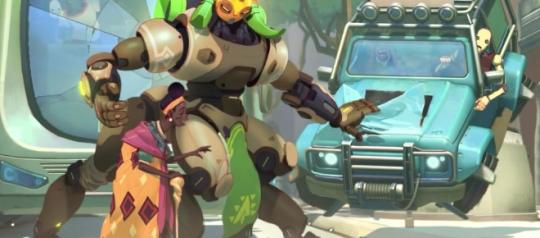
If you have made it this far, thank you.
In short this story is cute and an easy summer read. It has all the charm of a child’s cartoon show. (Netflix, if you’re listening, this would be an excellent addition to your animated line of shows. I’d love to see it in the vein of the animated short for Doomfist’s reveal.) The dynamic of these over the top characters are perfect for the small screen. The brightly colored and exquisite atmosphere of Numani deserves center stage.
Even with the heavy use of in-game dialogue and voice interactions rather than new developments, this story was worth the read. Not the masterpiece or lore rich epic I’m hoping for. Stylistically cute. A shout out to fans, but not a gateway to non-fans. If you read this book, you must have prior knowledge of the characters and setting from the game and character releases.
All that said, I do hope there are more stories. The listing of The Hero of Numabi as Overwatch #1 gives me hope. I would love to see more lore rich stories that can stand alone without relying heavily on game play, where every other sentence seems like it is borrowed from the game.
Efi and Orisa may seem like periphery characters now, but they hold promise to boost the Overwatch world.

Side note: I love the original Overwatch cast. But reading this story has made me want to see more Lucio in the future. Lucio feels like he could be the leader Overwatch needs and deserves in order to bring it back into respectful prominence.
#overwatch#The Hero of Numbani#book review#nicky drayden#efi#overwatch orisa#efi oladele#lucio correia dos santos#lucio#Doomfist#akande ogundimu#summer read#overwatch book#easy read#grade school level#lore#cartoon#comic#literary criticism#critique#review#not a masterpiece#wish it was written for a higher reading level#feel like I'm missing why it has a 4.2/5 stars on goodreads#good for children#3/5 stars because I thought it was cute#2/5 for literary appeal just not doing it for me#I would read it again#I will look into this author's other works#a beginning chapter reading book
33 notes
·
View notes
Text
3/7 Ruins: Legend of Souhachi Kiraku
1 2 x 4a 4b 5 6 7
So the reason I wanted to group Gilag and Alito together is because Alito has plenty of substance in his ruins while Gilag is just,,, Hnng they would've balanced each other out but nope, heres Gilag's Ruins

So uhh Gilag is supposed to be a joke Barian Emperor. I get that. He’s the first to be fully revealed and he starts off as an imposing threat for, like, two episodes. Then he goes off???? draws manga and watches anime and lives in the school gym and he has no brain cells as clearly evidenced by the Friendship Game episode but also he kills.
Being such, Gilag has the shortest stick of the Emperors (almost on par with Merag but she has a prominent connection to the main Barian Emperor narrative). I’m not being figurative by-the-by. He has ONE episode to cover the legend of his ruins while the others get two episodes minimum, Nasch got like five total or something, so I can see that the writers,,, did not really care about Gilag. Which is unfortunate, but this is going to be my most out-there analysis because of the situation.

Unlike the other Emperors who have new settings for their ruins, Gilag’s ruins is the Duel Lodge.
This isn’t a new location nor does it reveal that much about his character (after all, the Lodge was meant to develop Yuma and Astral’s character during their first visit in season 1 and nothing new happened to this place during the Mythyrian Arc.)
But this means he should have the closest connection to Rokujuro and Yamikawa, but to my knowledge, the writers didn’t do anything with this aside from Gilag being the one who kills them during the Barian Onslaught Arc. Maybe there could be a connection to how Yamikawa felt betrayed by Rokujuro during the first season of Zexal. He attacked him, and then they made up soon after. This is similar to the story of Ponta and Gilag, but there isn’t much parallelism besides “two close persons becoming distant before making up”.
The most important outcome of the ruins is the reveal of the Mythyrian Guardian, Ponta the Tanuki, and Ponta is what this essay is going to be mainly about.
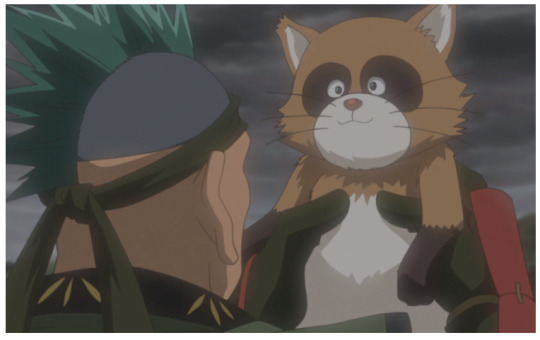
Like most of the Emperors, the Guardians often play a role in their legends. More often than not, the Guardians are the Mythyrian Numbers; they are tasked with protecting the Emperors (Mach, Abyss, and Jinlon are the clearest examples). Ponta is the strangest one because he is the only Guardian to exist as his own physical entity. This is seen in the show’s finale. He’s able to exist as himself without being attached to the Number card, and this may seem strange until you consider what happens in the Legend of Gilag (or Souhachi Kiraku if you want to get technical)

Gilag’s legend is a bit tough to grasp because there isn’t a single narrator.
In the text of the show, Rokujuro reveals that Gilag was a benevolent, smart, and powerful warrior during the Sengoku Era (which is characterized by military and social conflicts). He distributed his wealth from his conquests with the peasants rather than horde it with his vassals.
From Ponta, we find that Gilag found Ponta in the battlefield, saved him, and they formed a friendship. Ponta became his Kagemusha (a doppelganger/shadow warrior) and helped him win his battles. He was the one responsible for all of Gilag’s fame and fortunes. He says that Gilag was jealous of his strength, got rid of him,and then perished in the battlefield. Keep in mind that Ponta isn’t omniscient, and he clearly resents Gilag when he says this, so this source should be taken with a grain of salt (The episode is called “Yuma Confused!? The Unreliable Account of Gilag the Tanuki”).
From Gilag, it was discovered that the vassals were unhappy with him distributing the wealth, and they were going to rebel against him. To protect Ponta, Gilag forced him to leave so he could deal with the rebels. He ends up presumably dying in a burning building.
Finally, upon freeing him from the curse, it is revealed that Don Thousand influenced the vassals to rebel against Gilag, and in order to fill him with hatred over the betrayal, he placed the Over-Hundred Number “Number 106: Huge Rock Palm - Giant Hand” in his heart, allowing him to pass onto Barian World. It ended with Gilag perishing in a burning building with the rebels cornering him.

So what happened here?
With the Emperors, I strongly believe that the personalities they have as Barian Emperors are an extension of true personalities as humans (compare this to when Gilag and Alito got an extra dosage on Don Thousand, for example). With Vector, a major personality-changing curse was embedded into him at such a young age that his evilness is part of his true personality (or as said by Yuma, the “kind” Vector still exists as Rei Shingetsu), while most of the other Emperors inherit their curse shortly before their death. What we see now is most likely how they were originally, plus maybe a thousand years of them as Emperors.
So Gilag is, according to Yuma, “a despicable bastard, stingy, and an annoying jerk”. From his schemes in the show, we clearly see that he is not smart. All of his plans fail, he lacks foresight, and he gets distracted very easily. But he also cares deeply about his bond with Alito. This bond was strong enough to knock Don Thousand’s curse out of him. So this makes it tough to decipher the actual story because the Gilag of the present is nothing like the Gilag of the past.
Using this information, I can say that each narrator has elements of the truth. I believe that Gilag is strong and passionate about things he loves (idols, manga, and his country I presume), but he’s arrogant and has more brawn than brains. Gilag is only as strong as his plans are (under the orders of Nasch and Don Thousand, he usually gets the job done without an issue. When he has to make his own decisions, yikes). Meanwhile, I believe that Ponta is the one holding most of the wisdom, strategy, and brains.

Together with their strength and wisdom, they balanced each other and created the Legend of Souhachi Kiraku.
Also, bear in mind that Gilag has the only legend that has a non-Barian name attached to it (Legend of The Cursed Royal Palace, Legend of the Gladiator, Legend of the Dragons, and Legend of an Ancient Hero). The Legend of Souhachi Kiraku isn’t the product of Gilag or Ponta, but Gilag and Ponta.
From here, the rest of the words spoken by Gilag should be true. He said he “completely made it up”, but he also muttered “how did I know about the legend?” afterwards to tell the audience that what he said is indeed true. The reveal of his actual memories reaffirms this.
So the true story is that Gilag and Ponta worked in unison to defeat their enemies. They distributed their wealth among the peasants. The vassals were angry that they weren’t receiving the spoils from the battles, and with the influence of Don Thousand, the vassals plotted to betray Kiraku (as in Gilag and Ponta). In order to protect Ponta, Gilag banished him and sent him away. Gilag perishes in the rebels’ fires. Ponta later dies of old age.
With Don Thousand, he interjects into the story at two points. First by influencing the vassals to turn on Gilag, then again by placing hatred in his heart.

Why I think Don Thousand comes in twice is because the first instance wasn’t enough to alter Gilag’s fate as a Barian.
For Gilag, the satisfaction of saving Ponta meant he could still ascend into Astral World; as long as his best friend was safe, he was unfazed by vassals rebellion. Don Thousand went in one more time to induce hatred into him, sealing his Barian fate as he perished. This is most similar to the fate of Mizael (influenced the people to turn on Mizael and Jinlon, and then implanted hatred into his heart as he died) opposed to, say, Vector whose single personality swap set him straight for Barian World, or Nasch who didn’t need to be injected with hatred or altered like Mizael or Gilag; his entire life sucked so badly (due to Don interfering with Vector and Merag, yes, but he did not touch Nasch at all) that he chose to go to Barian World.
Enough about the other Emperors though, let’s talk about the Guardian of the Mythyrian Number, Ponta.
Like most of the Guardians, Ponta is both the Guardian and the Mythyrian Number “Number 64: Veteran Tanuki Sandayu”. And although I try to keep the discussion in the realm of the original/OCG, it should also be noted that in the TCG, this card’s name is “Number 64: Ronin Raccoon Sandayu”. Veteran means experienced fighter, and Ronin means wanderer, or a warrior without a master. In both cases, it describes what Ponta represents in his relationship with Gilag.
To those unaware, Ponta is based on an extant animal known as the Japanese raccoon dog, or tanuki.

Ponta himself is not a regular tanuki as he is based on the yokai, Bake-danuki. Bake-danuki are known to be the cunning, trickster type whose main trait is transforming into other apparitions. Despite this, they are also associated with good fortune (which they carry in their massive fucking gonads), virtue, and strength. Most of these traits can be seen within the Mythyrian Number that represents Ponta, or more importantly, the tokens that it spawns.

These “Kagemusha Tanuki Tokens” hold most of the Bake-danuki traits which I am now taking from Wikipedia because they summarized better than I can:

These tokens also have the ability to turn into the strongest monster on the field (appropriately transforming with a leaf) too. Anyways, Tanuki legends are really fascinating and there is a lot of information on them, go here if you wanna learn more (this is a really cool site in general, especially if you wanna read about yokai and other neat things).
Despite being his Guardian, Ponta loathes Gilag, blaming Gilag for his own death as well as Ponta’s fate as a Kagemusha. He hates that Gilag got all the credit for the Legend of Souhachi Kiraku while Ponta was banished and locked away in a statue with Gilag’s face on it. All in all, Ponta wants to be his own being. He no longer wants to be a Kagemusha, a shadow, for a man he despises.
Instead, and hear me out, I think Ponta wants to be the actual Gilag.
This can be seen in how he treats the Mythyrian Number as well as his interaction with Gilag. Ponta’s first action upon meeting Gilag was, ironically, stealing his body. This is strange for a creature that doesn’t want to be remembered as someone else, and then he becomes that exact same person. However, it should be noted that Ponta’s name isn't revealed until the very end of the episode, so perhaps he isn’t interested in letting people know that he’s “Ponta” at all.
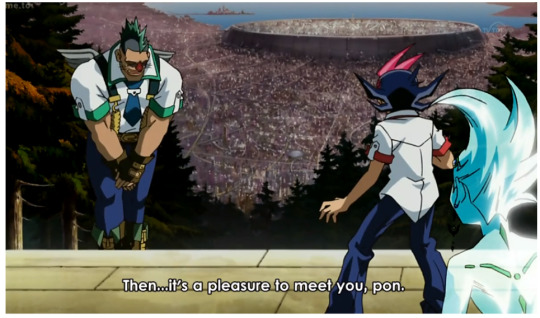
He was content going forward in life as Gilag.
And remember, Ponta died during the Sengoku Era (1400s-1600s), so he was trapped in the statue of Kiraku for at least 400 years. During this time, he was referred to as only Kiraku, never as Ponta. After so long, after 400 years of never hearing his real name or being recognized as himself, it isn’t a stretch that Ponta doesn’t see himself as “Ponta” anymore. He sees himself as a shadow of Gilag, and so he made it a plan to be the real Gilag if he ever gets the chance, or at least, be in his body. Hence, he took over Gilag’s body.
Even when he hijacked Yuma’s body, he preferred being in Gilag’s body so much that he swapped back after he finished cheating.
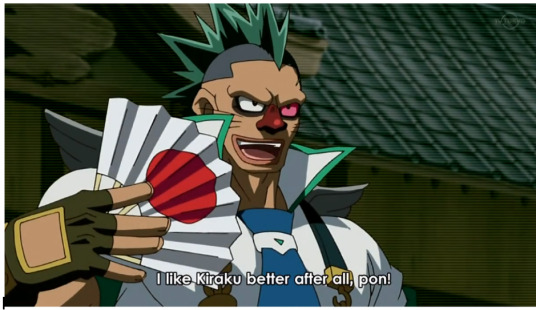
You can see this in how he uses his Mythyrian Number, too. Like most of the other Guardians, Ponta is the Guardian and the Mythyrian Number, “Number 64: Veteran Tanuki Sandayu”. During the duel, Ponta utilizes “Veteran Tanuki Sandayu”, the true warrior, while the “Kagemusha Tanuki Tokens” are Ponta’s shadows. This is made more apparent when the tokens (which normally turn into any monster on the field with the highest attack points) turn into copies of “Number 64: Veteran Tanuki Sandayu“, mimicking his relationship with Gilag.

Ponta wants to see himself as an actual warrior with Kagemusha of his own, rather than the other way around. He even becomes concerned when Yuma attacks his Kagemusha.
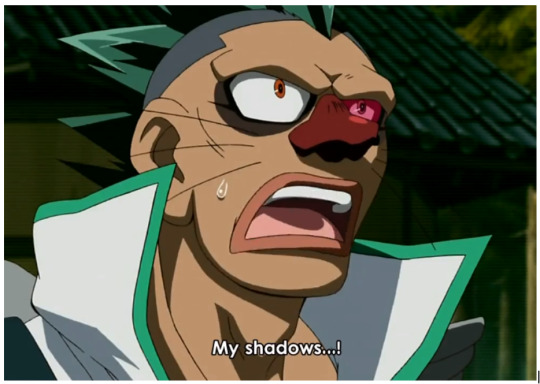
Personally, I see this sequence as Ponta having a sudden detachment from his dream of “being Kiraku”. Deep down, he still sees himself as a Kagemusha, and so when he sees the destruction of the Kagemusha Tokens, he also sees this as a destruction of himself.
When he finally loses, he mutters, “I’m not a shadow, I’m not a shadow,” almost as though he internalized this perception of himself while desiring nothing more than to reject it.
Ponta knows that he isn’t the true Gilag, but after half a millennium of being a Kagemusha to Gilag, I don’t think he knows who he is anymore.

This changes when Gilag gets his human memories back and approaches him. Upon telling Ponta that “you’re Ponta”, Ponta appears surprised to hear his actual name. By hearing someone speak his name after 400-something years, Ponta finally sees himself as his own person again.
And believe it or not, this idea falls into why he exists as his own raccoon dog after the show ended.
Ponta decides that he can be his own person. He doesn’t need to be tied down by Kiraku or anything else. This is why he willingly leaves Gilag’s body and detaches himself from the Mythyrian Number.
This is evidenced when Astral absorbs the Number first, and then Ponta emerges from the body; at this point, Ponta is no longer a Guardian but simply a Tanuki.

Also, if Ponta is still the Guardian/Mythyrian Number, then Gilag should’ve received the “Number 64: Veteran Tanuki Sandayu” when he eh-hem,
swallows Ponta.
Ponta comes back later, of course. Along with the Mythyrian Number, Alito and Ponta, Gilag’s two best friends are used to free Gilag from Don Thousand’s curse.
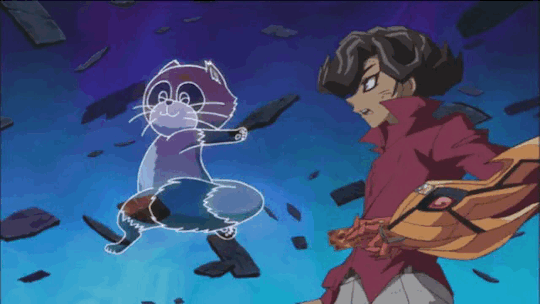
They even make up afterwards.

And before anyone starts, I do not know why Ponta is still friends with Gilag after all of this.
Like really im not joking. im not saying that ponta is that type of raccoon, but if my friend ate me, id be kinda pissed ngl
like maybe these scenes?? Gilag sent Ponta away under the pretense of hoarding the fame for himself. After finding out Gilag died, Ponta was devastated. He cried for a moment, saying that Gilag would still be alive if Ponta wasn’t banished. But then he convinced himself that Gilag deserved it.

Ponta obviously cares for Gilag despite how big of “a despicable bastard, stingy, and an annoying jerk” he is. Ponta also says that he would’ve preferred dying with Gilag in battle rather than be sent away. Ponta clearly sees something in Gilag that makes him worth fighting for.
Maybe Gilag has a good heart under his questionable tendencies.
When Ponta loses the duel with Yuma, the immediate reaction of Gilag tells us that he is very concerned over the safety of Ponta, but then he retracts himself, like he remembers he’s supposed to be tough and emotionless.
And to be honest. Ponta could be like, like “hey, my buddy Kiraku, getting mind controlled by Don Thousand really sucks, might eat me because he’s a little grumpy-grump, it happens you know, no big deal”.
They get drunk together.

It’s the Sengoku Period. They probably do a lot of stuff off-screen like Gilag usually does with Alito. Maybe having an occasional fallout or all of that is normal. I truly don’t know.
What I do know is that Ponta is able to complete his arc at the end of the show. Without being tied down as a Kagemusha, a Guardian, or a Mythyrian Number, he is able to exist as a physical being in the modern world.

So Ponta has a complete character arc. Not complaining, but I do wish that the ruins has more to do with Gilag himself. The information on his past life is interesting enough, but the story is more about Ponta than Gilag. And what we found out about Gilag’s current life is... alright.

The connection between his Mythyrian Number and Over-Hundred Monster is minimal. Aside from being both Earth Monsters, I do not see any connection between the two nor why its a giant hand. “Number 64: Veteran Tanuki Sandayu” kinda features Gilag and Ponta as a warrior and a Kagemusha, which I thought is neat.
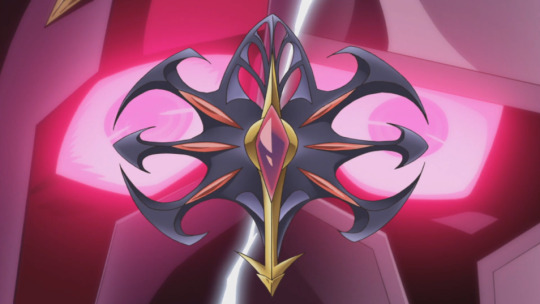
The most disappointing thing is that the writers didn’t do anything with the concept of Gilag being possessed by Don Thousand. I mean, Alito went absolutely berserk. Like from baby child to unhinged bloodlust. Gilag is—he’s just Gilag, that’s just regular Gilag i swear. Like, maybe Gilag on steroids the second time, but Don Thousand looks at this guy eating live raccoons and said “ssssshyyeah, I don’t need to fix this one.”
#long post#my hc is that don was supoosed to grab ponta but he made a mistake and ended up with gilag#like that raccoon wouldve wrecked as an Emperor#zexal#gilag#girag#dyzarc writes#barian biology
41 notes
·
View notes
Text
“SHOULD I WATCH LOVE EATER?”: A INFORMATIONAL GUIDE BY YOURS TRULY
PSA: THERE ARE NO LOVE EATER SPOILERS IN THIS POST
Ok, this is gonna be a post where I try to clear the air and provide some facts about the whole Love Eater airing in two freaking days situation, since i’ve seen various misconceptions floating around. Now, am I going to watch it? I dunno yet. But I’m going to give the information I got about this whole thing and a paragraph with my opinion, and I’ll let you decide after this post. (I will also be sourcing all of my information.)
So without further ado, let’s get into this grammar filled disaster.
THE CONTEXT
So, some of you who are seeing this post may have stumbled into the fandom currently and experienced something like this:

If you fit this description (which I’m sure a lot of you do), allow me to explain.
The Ukrainian Channel Plus Plus has just announced that they are airing the first part of the season 3 finale, Love Eater, October 13th at 9:55 pm (Ukrainian Time). Aka, this friggin Sunday Source
Now, we are also getting the episode Kwami Buster tomorrow 8:15 am local time (Bern Switzerland). Source
So, great right? Two episodes airing one after the other, one being the first part of the finale? So... why the fuss?
A MATTER OF EPISODE ORDER
Ok so this is the major, if not only, reason that almost no one wants this episode to air.
Many are saying they don’t want it to air because it’s after Chat Blanc (which is true), or because there’s still some episodes that take place before this left to air (which is also true).
However, one has to ask these two questions:
A) Just how much will it spoil Chat Blanc?
and
B) How many episodes are left to air exactly?
And to answer both, let me get into my favorite subject: Chronological order

Before you aggressively comment that there is no chronological order, let me remind you of something most people forget... there is
Thomas Astruc has said back in season 2 that there is no “chronological order per se” because a lot of episodes in miraculous can be non-plot related and it doesn’t really matter the order you watch it in. However, he also said that the production order of the series respects all the main chronological events... meaning that there is a chronological order for plot episodes (something that makes up the entirety of season 3), and that this order is the production order. Source
So, taking that into account, let’s get into our two questions.
Here’s a list of all the episodes in season 3, both aired and unaired, in chronological order. See if you notice something:


Thats right! Firstly, Ladybug, a episode already watched by most of the fandom, takes place after both Chat Blanc and Felix. And the episode contains no game changing information (like a reveal) about Chat Blanc. Also notice how Ladybug is right before the Finale.
Secondly, there are only 5 episodes left in season 3. One is Kwami Buster airing tomorrow, one is Finale part 2, and the other two are Chat Blanc and Felix. Not as many episodes as you thought huh?
So, yeah. Maybe the jump isn’t that major. However...
A matter of airing dates, or as I like to call it “Dude I don’t want to watch this w/o knowing when Season Finale pt.2 will air”
I hear you!! I am very apprehensive about that to!!
However, something you may not know is that we actually have confirmed airing dates for the rest of season 3!!! Or at least, when they will air on one particular channel.
TeleQuebec has announced on what days they will be airing the rest of season 3. These dates are set and confirmed Source
And these dates areeee: (not including Kwami Buster and finale pt 1 since we have those already):
Chat Blanc~ November 17
Felix~ November 23
Miracle Queen (Finale pt 2)~ December 1
So uhhhh.... yeah. Oof.
However KEEP IN MIND THIS IS ONLY FOR THIS CHANNEL!!! A ton of other channels air Miraculous, and there’s a extremely high chance that one of em will air these episodes before these dates. These dates due serve as deadlines however, kinda saying “you will get this episode no later than this date.”
So there’s a idea for by when the episode will be coming out, in case you wanted one.
So. What am I doing you may ask....
CONCLUSION: AKA MY DILEMA
So I tried to just give straight information that’s not opinionated, but in case you were wondering where I stand, i’m not sure. I mean, I’m not to worried about chat blanc spoilers after ladybug, and with Kwami Buster I’d love to watch it. So what’s stopping me? Well it’s two things.
The first, very minor one, is language. It’s airing in Russian im pretty sure, and usually you have to wait a whileeee for the fandom to post some captions. And I’m one that doesn’t like to watch it w/o captions a lot of the time since it kinda ruins the flow of the story/ shock factor. However I usually get over this so it’s not that big of a deal.
The 2nd, more compelling thing, is the story. I like watching episodes with context of what happened to these dorks prior to this and other lil moments they may have had. I like to know their expierences for major episodes like this, and in this case two major expierences (those being chat Blanc and Felix) will be missing. Even if there’s no spoilers, knowing that they would have shared two more experiences together by the time of this episode and not knowing what they are... troubles me. Sure I could rewatch once the eps do air, but it’s not the same as the first watch, ya know?
So, all in all, I just wanted to inform you guys of all we got since I’ve seen some misconceptions and I care about y’all. This took forever and I hope I was able to serve some help.
Happy watching, and remember...
BANANOIR IS ALWAYS WATCHING

EXTREMELY IMPORTANT EDIT:
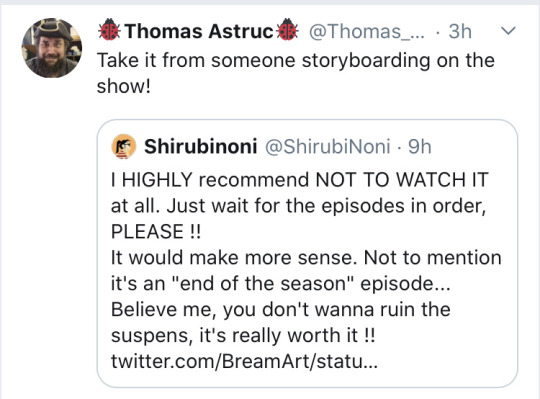
Yep, that’s right. Two crew members, one of them being the creator, are telling us NOT to watch this episode. Even the assistant director of the show, Winny, said not to. (See the reblog of this post)
So, yeah. Watching Love Eater does not seem like a good idea anymore. Tag your spoilers, and don’t reward the network (push push) by watching it on one of their sites.
#SO MUCH WORK#FOR ONLY 2 NOTES PROBABLY#still worth it though if I could help two people :)#please reblog!!!#anywya not tagging love eater since some people have blacklisted that tag#any questions you can leave me a Ask#!#mlb#miraculous ladybug#miraculous#ml#ladybug#tales of ladybug and cat noir#ml news#miraculous: tales of ladybug and cat noir#miraculous ladybug: tales of ladybug and chat noir#mine
128 notes
·
View notes
Text
On Falling and Identity
One thing I’ve fallen out of the habit of doing is elaborate metas based on my fanfics every Wednesday. First I took a long hiatus to finish “What it Means to Be A Demon” and then I started posting it and it was angsty and that made me tired.
Plus, I’ve been posting chapters on Wednesdays, and busy enough that I couldn’t do a post and a meta.
But I have some time today, so I thought I’d share some of my thoughts on Falling and Identity. Because there’s more to “What it Means to Be A Demon” than physically and emotionally torturing Crowley (there’s that, too).
Names
One thing I think we can all agree on: the demons in Good Omens are not using the names they’d had as angels. We have plenty of examples: Cra(o)wley, Hastur, Ligur, Beelzebub, Dagon, even Satan (on the to-do list: re-watch while keeping track of various names used for the devil. I’m trying to remember where the name Lucifer is used outside Crowley’s drunken rant, and even that is a memory of their time in Heaven).

(Fun fact: when I searched the GIFs for “Good Omens Devil” one of the results I got was Gabriel, and...technically incorrect, but still accurate.)
Regardless, none of these really fit the pattern of angelic names (Gabriel, Uriel and Michael are all standard angel names; Aziraphale does fit this phonetically, but the spelling is different; Sandalphon less so, but still a traditionally angelic name). So, disregarding the possibility that angels somehow rebelled and Fell based on the names they already had, it seems clear that they chose new names after Falling.
Were they forced to change their names? Did they forget their original names? Did they voluntarily give them up? We don’t know this, but I’m sure going to speculate!
Crowley, however, is the only one we know who changes his name, from Crawly/Crawley (note it’s Crawly in the book but Crawley in the script book). It’s called attention to very early in both - the first post-Eden scene in book and show is our two maggot husbands lurking in the graveyard, and one of the first things they comment on is Crowley’s name change, “what’s he calling himself these days?”

I find it rather interesting that the demon who changed his name - something notable enough for others to comment on - is also the one who winds up the most independent, the most free-thinking, the most human.
Identity
Names and identity are tied together in Good Omens.
Most notable version of this is Dog, a terrifying hellhound who very abruptly isn’t. And the moment he changes is the moment he receives his name: in the book, his shape changes as Adam describes his ideal dog, but his personality changes at the naming; on the show, everything changes at once.

From the book: “The hound waited. This was the moment. The Naming. This would give it its purpose, its function, its identity.” (page 82)
There’s also the “Form shapes nature” passage on page 132 - in short, now that he looks like a small, yappy dog, he is a small, yappy dog. It can’t just be that simple, though - the Horsepeople (well, 3 out of 4) all spend much of the series walking around in very human bodies, yet their nature doesn’t become more human. So it’s not just being in the form, it’s accepting the form, letting the form be more than just the mask you wear.
So bring this back to the demons. On the series, we see that they have different forms in Hell and on Earth - not radically different, but the Hell version is more extreme.
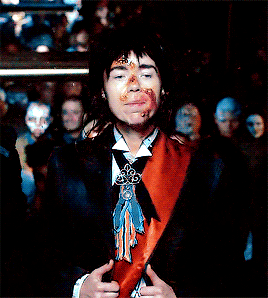
Beelzebub in Hell
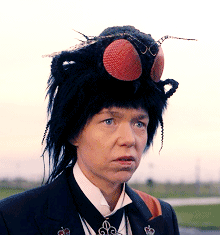
Beelzebub on Earth
Crowley even more so - he appears as a giant snake, as a human with snake eyes, and as...whatever that thing was at the paintball game. It was vaguely snake-y. So we know they have options for how demonic they appear. Whether by choice or some other means, Crowley’s habitual form is the most human. As a result, his actions seem to be the most human.
Importantly, while it might seem fatalistic to say “Names determine who you are, Form determines nature” - both of these are Crowley’s choice (and presumably other demons as well). He doesn’t want to look like a snake, so he doesn’t; he doesn’t think the name Crawly suits him, so he changes it. Changing his name, changing his form, creating his flash bastard persona - these are how he develops his identity. These are how he makes himself into something more than a demonic snake.
Headcanons
So now we get to the part where I explain how this ties into my story, “What it Means to Be A Demon.” I believe everything has at least been hinted at in the story so far, so I don’t feel as much like I’m spoiling my own plot.
Names were lost. I established this earlier in “Early Days,” but Crowley and the other demons can’t remember their original names, they were taken away as part of the act of Falling. For the purposes of “interpreting canon,” both options are plausible (names were taken or names were rejected), but this is the one I felt had more story potential, because it meant:
Identities were lost. This is a little tougher to explain, and I hope I’ve been able to make it clear in the story. The demons are no longer who they were as angels. They can remember their past lives...to an extent. Names and faces slide out of focus, scenes replay without context, they can’t connect things into a coherent story. And the sense of the being they were before the Fall is just...gone. They became No One.
Demons rebuilt new identities. They chose names for themselves, distinguished themselves, built up cults of personality if you will by attracting followers and supporters. Hastur and Ligur, for example, have clearly built their personalities around cruelty and intimidation, but each even has his slightly different brand, such as Hastur’s brutal honesty (a few metas have pointed out that he doesn’t lie, but his truths are extremely cruel). Appearance is also part of this - while the angels have a certain uniformity to their look, the demons each have a different take on the general theme of “humanoid but bestial.”
Demons, especially low-ranked demons, must fight to retain their identities. This is a major part of what’s going on in “What it Means to Be A Demon.” You sort of need other people to acknowledge your identity...this is something you’ve either experienced or not. Whether it’s a gender identity, a sexual orientation, a diagnosis, or just run-of-the-mill interests - when other people ignore, refuse to acknowledge or outright reject something about yourself you know to be true - it f***ing SUCKS. It makes you doubt yourself, it digs away at you, maybe it even makes you conform more to how other people think you should be, because you start to lack the strength to be who you know you should be, or makes you feel like a failure because you can’t be who they want you to be. In the story, Crowley (still Crawley, as it’s around 2400BC) is abused and tortured, but he’s also forced to take shapes based on what others ask of him; he’s told how to present, how to dress, where to go; the other demons even call him “Crawly” which sounds exactly the same but isn’t a name and trust me in these circumstances you can tell. And it wears away at him, makes him question who he is. Destroys the identity he’s built for himself
When they lose their identity, they become...something else. This is not really based on anything specific from the show, except the endless hordes of seemingly mindless demons in Hell. But if their identities are something they must fight to hold on to, what happens when they lose them? In my story, I’ve presented two options: the Nameless (basically mindless bodies who go where directed, do as told, don’t speak, don’t react, no signs that they even think), and Chaotic ones (imagine a Hellhound in human form - instead of mindless obedience, mindless violence). This is the fate that the demons - that Crowley - fight to avoid.
Crowley is not going to let this happen. I’m dead center in this story, so sorry if this is too much of a spoiler, but I did mark it Canon Compliant. The demon who makes an Arrangement with an angel, the demon swaggering around Shakespeare’s Globe, or performing daring Bastille and Nazi Church rescues, who asked for Holy Water because he was going to fight Hell if he needed to - that Crowley is not a demon under existential threat of oblivion. In “What it Means to Be A Demon,” his identity is under threat, because of the things he feels he needs to do to physically survive. But his story arc for this portion of the overall series is all about Crowley finding his identity, and forcing Hell to acknowledge it, one way or another. And over time - he changes to Crowley, he adopts Anthony and Anthony J as his names, his sense of style becomes more elaborate, more personalized, his possessions more solidly representative of his self. And, ultimately, he creates an identity that is strong enough to go against Hell.

So, those are some of my thoughts on DEMONS and FALLING and IDENTITY. I have mentioned that I have a lot of them. ;) If my ideas intrigue you (and if you have a strong stomach for angst and abuse), I hope you will check out my story! Here’s the link one more time:
Read it on AO3! (Rated T for violence, language, and potentially triggering scenes)
Here’s the whole series! (All but two stories are rated G, so if you prefer something lighter...)
#good omens meta#good omens prime#crowley#anthony j crowley#ineffable demon (crowley)#good omens hell#good omens fanfiction#good omens headcanons#ao3 link#sawdust of words#i wrote this instead of shoveling out my car#now i should probably go shovel out my car before it gets dark#oops too late
78 notes
·
View notes
Video
tumblr
The Untamed/陈情令 Rewatch, Episode 2 (spoilers for everything)
(covers MDZS chaps 6 - 10 and a bit of 13)
WangXian meter: 🐰🐰🐰🐰🐰🐰🐰🐰🐰
(a 🐰 is earned every time there is a WangXian scene or even when they’re just thinking of each other)
I always tell people when I’m trying to get them to watch The Untamed that when they get to this particular scene in the second episode, they’ll know if they will be into the show. To me, this is the game-changer moment: you’re either in or out after this. If this scene doesn’t emotionally move you enough to at least continue on with the drama, nothing else will. It is seriously one of the most romantic scenes I have ever seen captured on screen. This was the moment that made me realize not only was I now fully committed to CQL, but that I had also found a new obsession and was ready to devote myself to Mo Dao Zu Shi. After all, something that can lead to the creation of such a beautiful scene MUST hold other invaluable treasures. So into the MDZS rabbit hole I went, happily diving head first.

Even now I’m still amazed that this scene exists in the intact form that it does. I started The Untamed with little to no expectations, especially knowing the restrictions it was under AND having just finished Guardian and experiencing how poor creative decisions can arise due to censorship (or at least, using that as an excuse for their dumb story choices). As I mentioned previously, the first episode was a hard sell since they definitely did not put their best foot forward first, but I liked Xiao Zhan immediately and Wei Wuxian as a character was interesting enough that I wanted to learn more about his past that led to his death and rebirth. The small glimpses we saw of his relationship with Lan Zhan also fascinated me, but then with this second episode, the weak points of the pilot still remained: there was still bad CGI (the statue) and very amateurish technical mistakes (in the recognition scene, at one point, in a close-up shot they’re holding onto each other, but in the next far away backside shot they’re clearly standing apart from each other, only to return to holding each other once again once the camera cuts back to a close-up...whoever the editor is on CQL probably should dunk their head in the toilet every time these editing errors pop up) that made my initial viewing of this episode a frustrating one for most of its runtime. I think I spent most of my initial viewing just distracted, playing on my phone or something, until the big WangXian moment happened and then I was shocked and awed. I know I wasn’t paying close attention that first time because when I rewatched the episode later on, I realized I missed a lot of dialogue and details. I have since revisited this second episode numerous times more, and I do feel bad about how dismissive I was initially. It’s a pretty loaded episode: it has funny, poignant, creepy, mysterious, and cool moments while still feeding us bits of the overarching plot. I definitely have developed an affection for it since my first viewing and it’s become one of my favorite episodes in the series.
Of Pining & other Heart-achy Things

This simple line from Jiang Cheng is enough to make my eyes well up with tears: I can’t help but imagine Lan Zhan traveling around the world for sixteen years, most likely all alone, stopping at different places to play Inquiry, fervently hoping that maybe one day he’ll finally receive an answering chord from Wei Ying, only to be confronted by a deafening silence again and again and again. How utterly sad and disappointed he must have been every time, and yet still, he never gave up and just went to the next location to do the same thing and experience the same heavy disappointment all over again. If that doesn’t make your heart ache, I’m sorry to tell you, your heart is no longer functional.

It’s a detail I don’t remember if the novel covered, but I’m assuming that Lan Zhan was the one to bring Wei Ying’s inventions like the spirit attraction flag and the compass back to Gusu and incorporate them for use in his sect’s normal cultivation practices. I know other people have use his tools as well since that nameless cultivator at the start of the episode was also using the spirit compass, but I feel that with Lan Wangji, he probably purposefully acquired and adapted WWX’s techniques so that every time they’re used, they can serve as a reminder of Wei Ying for him. Though it does make me wonder how Lan Zhan managed to get those approved by his uncle; I can’t imagine Lan Qiren being ok with using anything that was created by the man whom he blames for the corruption of his beloved nephew and model student. Did LWJ just pretend he created them instead? That doesn’t even sound right. Maybe Uncle Lan decided to be merciful and just let Lan Zhan win this one since he was probably obviously miserable after Wei Ying’s death. Yeah, I can buy that scenario, especially since the flag and compass are pretty useful tools.
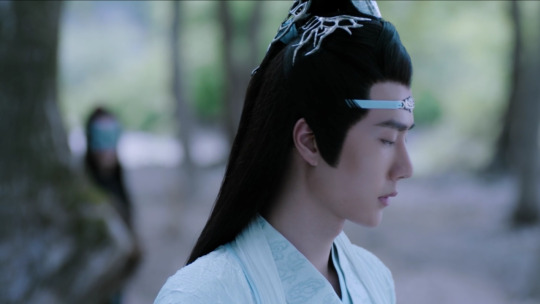
I wondered did LWJ already suspect “Mo Xuanyu” was Wei Ying before he started playing Wuji on his flute. It’s curious that he happened to be in that part of the forest at that time. I’m guessing his Wei Ying senses were tingled when he heard about Mo Xuanyu’s skills from Sizhui and the boys so that’s why he was hanging around the vicinity just in case MXY reveals his true identity. After waiting 16 years for this reunion, it’s no wonder Lan Zhan had no qualms about holding onto WWX’s wrist in public for much longer than socially appropriate.

I actually get a little emotional every time I rewatch this episode and watch Jin Ling display his mad archery skills because I would always think of how much he takes after his dad. His parents would’ve been so proud to see him all grown up like this; Shijie would’ve been so happy she probably would get teary-eyed as well every time she saw her boy in action. Sure, he’s a spoiled little princess, but he is also a pretty skilled princess with a heart of gold and I just wish they had more time together as a family.

They looked so happy, look at all those smiles. It really makes me so sad that Wei Ying will probably never be able to hug JC like that again, and of course he’ll never be able to hug Shijie period. Great now I want to cry again.
Lan Jingyi Appreciation Section
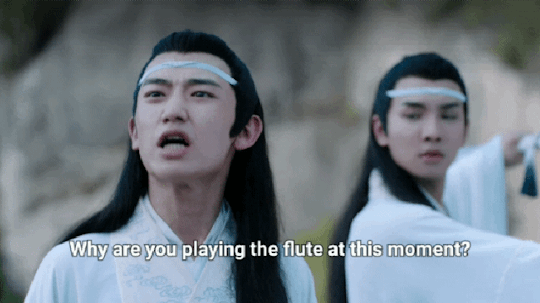
I don’t think I’ve ever mentioned this precious boy by name so far, so I wanted to take this opportunity to show him some much deserved love. Lan Jingyi with his resting bitch face and steady stream of snark was really the MVP of this episode. He actually made me laugh out loud a few times...in fact, he almost always makes me laugh as soon as he scrunches up his face like he’s smelling something bad. I recently saw someone mention that he’s really the most un-Lan of the Lans (sorry, I forgot who posted that so I apologies for not giving proper credit) and that is really the perfect description of him. I love this kid as much as I love Sizhui and Jin Ling, and I am also sincerely fascinated by him. I mean, who raised him in the Gusu Lan sect? Cuz I cannot imagine Lan Qiren being the one since Jingyi undoubtedly would’ve had all his snark driven out of him at an early age. Hell, the amount of disciplinary action he probably had to have gone through would’ve probably killed him at a young age. Did he join the sect when he was already fully formed so that’s why he’s still breaking Lan sect rules right and left? He threatened an old man and is like rude to everyone. I don’t know all 3000 rules but I’m pretty sure being mean to the elderly and insulting to supposedly mentally unstable people are probably not allowed. If anything, his disposition would make him more suitable for the Lanling Jin sect and yet he’s with the stuffy Lans. WHY? I could watch a whole spin-off series with just him and the other juniors as long as we get to learn about how he came to be with the Gusu Lan sect. He’s hilarious and adorable, and among the many the reasons why I wish we had more episodes for the present-day arc, one of them is because I wanted to spend more time with the juniors, especially Lan Jingyi, even if it meant the screenwriters would’ve had to go off book and create new scenes for them. It would’ve been well worth it to hear LJY throw more shade at people.
Random Bits of Randomness

It’s kinda crazy how WWX just stood there with his back turned, oblivious to Jin Ling’s attack. If Lan Zhan’s blade hadn’t blocked JL’s sword, that would’ve been the end of our main protagonist. I just thought that was such an odd scene...I would’ve felt just a little better if Wei Ying had at least had a little more awareness that an attack was heading for him and made some attempt to get out of the way.
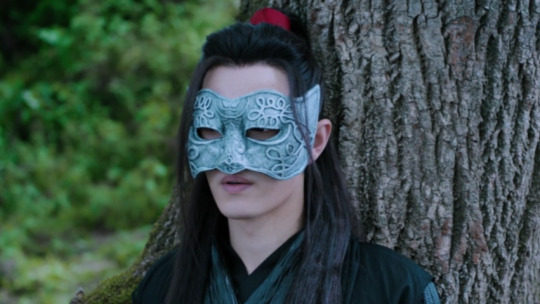
Ugh, that mask. First of all it’s ugly AF, and secondly it’s so freaking ill-fitting it was distracting. Would’ve been nice if the production team gave him a mask that actually fit his face. I mean, did it HAVE to be THAT damn big? I’m amazed they don’t have bts clips of Xiao Zhan tripping and hurting himself because the stupid mask blocked his vision.
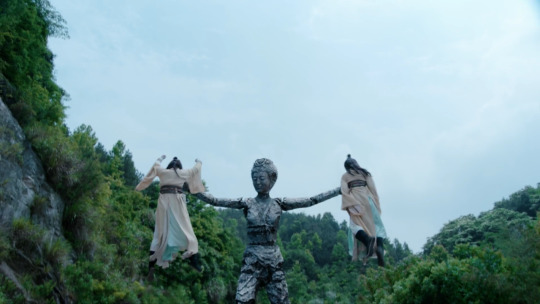
Other than being a brilliant mastermind and Oscar-worthy actor, Nie Huaisang has got to be one of the greatest cultivators if not THE greatest cultivator of all time to be able to conjure up an illusion like that. That thing was doing real damage to people. If it was just a phantom, what the heck was holding up those two cultivators in midair like that? And what kicked Jin Ling around? I know Wei Ying was able to drive people crazy with his flute during his Yiling Patriarch phase, but his handiwork still felt more grounded and reasonable than this.
Questions I still have (please feel free to answer them):
- Who was that old man at the grave? Someone NHS paid to just hang around the graves until the juniors and WWX came by?
- So NHS basically fucked up Yan’s entire family and God knows how many other people just to get WWX to eventually play his flute to lure Wen Ning out from wherever he was hiding?
- How did JGY not know Wen Ning escaped? Or did he just leave those details to Xue Yang so he didn’t really care about what happened to Wen Ning? I’m trying if this was addressed in the book but my mind is coming up empty. I don’t think it was brought up in the show though, or I just completely missed it.
Overall Episode Rating: 9 Lil Apples out of 10
#The Untamed#陈情令#spoilers#Untamed Rewatch#WangXian#Mo Dao Zu Shi#CQL#MDZS#魔道祖师#Grandmaster of Demonic Cultivation#Lan Zhan Lan Wangji#Wei Ying Wei Wuxian#Lan Jingyi#Jin Ling#Nie Huaisang#Jiang Yanli#Jin Zixuan#Jin Guangyao
111 notes
·
View notes
Text
Doctor Sleep, and How Cinema Helps Us Revisit Old Ghost
As I write this review, the phrase “Better late than never comes to mind.” Not only because I’m only just now seeing Director Mike Flanagan’s adaptation of Stephen King’s novel Doctor Sleep in mid December, but because I feel like this is a phrase Dan Torrance must have muttered to himself during the events of the film as well. Picking up after not only the first book, but the first movie as well (as most horror fans know, the two are very different affairs), Doctor Sleep manages to swiftly maneuver its way between both its source materials while creating a story of its own. Don’t be fooled though, as the Overlook Hotel is as horrifying as ever.
In the film we follow Dan Torrance, now I’m his 40s, as he struggles with the bottle much like his father Jack Torrance once did. We see that he uses this as a means to dull his Shine; a coping mechanism that only seems to break him down both mentally and physically. Meanwhile, we also meet young Abra Stone. Abra’s Shine is perhaps the strongest felt in decades, as we see it catches the attention of Rose The Hat and her family The True Knot. Rose is a Pennywise-type character of sorts who hunts down those with the ability to Shine, using fear to strengthen (or even season) their essence, which her and the True Knot then consume.
Bringing Dan Torrance back to the silver screen is actor Ewan McGregor, Rebecca Ferguson portrays Rose the Hat, and finally Abra Stone is portrayed by Kyliegh Curran. The cast is rounded out by some Flanagan regulars such as Carel Struycken (Grandpa Flick, The Moonlight Man in Gerald’s Game), Violet McGraw (Violet, young Nell Crain in The Haunting of Hill House) and Henry Thomas (in a role I won’t spoil for ya, young Hugh Crain in The Haunting of Hill House).
McGregor plays Dan wonderfully, embodying the sort of longing for peace Dan Torrance has wanted ever since his family stepped foot into the Overlook Hotel. Ferguson is menacing and cunning as Rose, and has this sort of animalistic appeal which just jumps off the screen. Curran brings to life my favorite character from the novel, playing Abra as confident and sure of herself, all the while still amazed by her own abilities. I was afraid the movie wouldn’t focus on Abra enough, but luckily we get plenty of time for her character to grow and learn, Curran breathing life into an already fantastic character!
The film is shot beautifully, with cinematographer Michael Fimognari creating an eerie and cold look to the film. There are sequences that pay tribute to Kubrick’s film, and they are shot with such care that it had me grinning from ear to ear. Along with the look of the film, The Newton Brother’s do a magnificent job with the score. Once again, we have tributes to Kubrick’s film and they help to really solidify the connection I feel Flanagan was going for.
As I mentioned, the film pulls from Stephen King’s literary sequel to The Shining, while also calling back to Stanley Kubrick’s adaptation of King’s original novel. Director Mike Flanagan has a task in front of him that I am hardly jealous of, yet he manages to respect both. As a page to screen adaptation, Flanagan does his best to leave in as many of the novel’s plot points while still having enough vision to cut out, or change, some pretty big aspects. I was afraid we’d get a complete rehashing of most of the story to help it fit in better with Kubrick’s film, but for the most part, the first two acts really manage to follow King’s work.
Where the film takes its biggest liberties are in the opening sequence and the films climax. Though I do wish Flanagan had stuck to King’s original ending, I did enjoy how he decided to wrap things up. Furthermore, King’s ending no longer made sense in the context of the film, as Flanagan changes a major driving force for Dan pretty early on. Where Flanagan’s ending succeeds most is in reconciling the ending of Kucbrick’s film and The Shining novel. Though this isn’t a retcon by any means, it helps to bring closure to many of the stories characters, and gives us an amazing scene between McGregor and Henry Thomas which I did NOT see coming.
Along with its visuals and performances, Doctor Sleep has solidified Mike Flanagan as one of the strongest directors in the horror genre today. In every one of his outings, you feel that Flanagan has a great understanding of classic film making. He manages to find a balance between terror and heart in an age when Hollywood horror tends to be more and more flashy. Doctor Sleep takes its time, much in the way The Shining did, building dread and tension with the patience it takes to let a scare really get its claws into you.
Mike Flanagan has managed to combine the worlds of screen and page into an experience that I feel will satisfy both King’s film and literary fans. With knock out performances from the entire cast, stunning visuals and music which plants you firmly in the world of the Shining, Doctor Sleep is certainly a film that needs to be experienced in theaters. Even if you’re catching a 10:30 showing in mid December, with a film of this caliber, it’s certainly better late than never.
Rating: 5 Full Moons out of 5 🌕🌕🌕🌕🌕

#doctor sleep#mike flanagan#stephen king#the shining#horror films#film reviews#moonlight madness#moonlight madness reviews
27 notes
·
View notes
Text
2010s Art: Music, Games, and TV
So I love all forms of art. It may not seem like it since I tend to stick mainly to movies, with the odd cartoon or video game thrown in, but that’s really because movies are more my thing due to not being massive time investments. Like, don’t get me wrong, I gamed, I watched TV, I listened to music, but it was a lot more casual than my deep dive into becoming a major cinephile.
With games and TV, it was mostly issues of money and time respectively. I have a few consoles, mostly Nintendo and Sony ones, and my wife helped me experience Xbox games, but I just don’t have the money needed to experience every good game that comes out. With TV, the time investment is the biggest roadblock, especially when all the best shows have hour-long episodes these days. With movies, I just have to spend 90 minutes to two hours on average; for TV, it’s countless hours I could be watching movies. As for music… well, I listened to a lot, I just don’t feel totally qualified to properly rank and list songs and albums.
So instead of the big decade-spanning list for movies that I’m doing, I’m going to go over some things I enjoyed from the past decade and maybe a few things I didn’t in music, TV, and video games. Here’s a little guide so you know what stuff is something I consider one of my absolute favorites in any given medium - if it’s from this decade, it will be in bold, and if it’s from a previous decade but I experienced it this decade, it will be underlined.
Television
I figured I’d get this out of the way first since it’s the medium I have the least experience with. Let me put it this way: I have seen only one season of Game of Thrones, the first one (and by all accounts I dodged a bullet by dropping that show). I also had the misfortune of jumping in to The Walking Dead right as it was gearing up for its abysmal second season, which turned me off that and led to me only watching an episode here or there.
I had better luck watching live action shows on streaming. I managed to get through almost all of Pretty Little Liars on Netflix, which was a chore in and of itself; it’s a good show, but boy could it ever get arbitrary and frustrating. Speaking of Netflix, I think it goes without saying that Stranger Things is their best effort; from the likable cast of kids to the awesome soundtrack, even though it never really surpasses season one the show always has something cool going on in one of its plots. My other favorite from Netflix would probably be their take on A Series if Unfortunate Events, which is how you do adaptation expansion right; everything they add feels like it’s in service of fleshing out Lemony Snicket’s dismal world, as well as giving Patrick Warburton an incredible dramatic role as the Lemony narrator himself.

Amazon managed to score two hits in my book. The first is the unbelievably fun and charming Good Omens, a miniseries that somehow got me to love David Tennant and Michael Sheen more than I already did. The second was the gory joyride that is The Boys which while not the smartest or most original superhero satire is definitely the most fun.
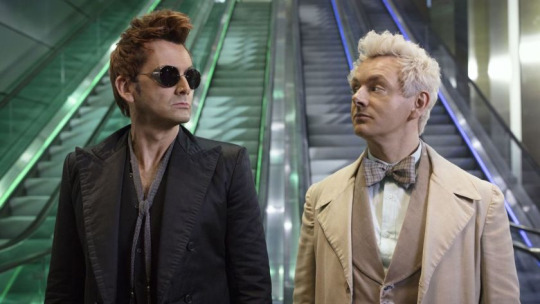
While I didn’t watch the whole show and would not consider it one of my favorites, I do want to give props to Hannibal for introducing me to Mads Mikkelsen. As far as I’m concerned, he’s the only person aside from Hopkins worthy of playing everyone’s favorite cannibal. Another show I DO consider a favorite despite slacking on keeping up with it is Ash vs. Evil Dead; I only needed to see a single season of Bruce back with the boomstick to know this show was a masterpiece.
On the animated side I have much more to talk about. Not since the 90s have we been spoiled with so many genuinely great and varied cartoons. We got Adventure Time, Regular Show, Steven Universe… really, Cartoon Network raised the bar this decade and made up for an awful 2000s. They even finally gave Samurai Jack a conclusion, which despite the mixed results, was still a real exciting phenomenon to experience.

Of course, my favorite CN show came from Adult Swim. I am of course referring to Rick & Morty, a fun sci-fi adventure comedy that attracted the most obnoxious fanbase possible in record time. While certainly not a show you need a high IQ to understand and having an atrocious third season, it still manages to be funny and thought provoking in equal amounts. Seriously though. Fuck season 3.
My Little Pony: Friendship is Magic is another great show that I sadly fell off the wagon of around the fifth or sixth season. It never got bad of course but it never really engaged me like the older episodes, though what I’ve heard of the last season makes me wish I’d kept up with it. It was a great show with a lot of heart and character, and I’m not sure we’ll ever see a show like it again.

Netflix did not slack in the animation department; I didn’t catch their most famous show (it’s the one about a certain Horseman) but I did catch their fantastic take on Castlevania, which as a huge fan of the series was a real treat. Where the fuck is Grant though?
My two favorite shows of the decade, however, are what I see as the pinnacle of East and West: Jojo’s Bizarre Adventure and Gravity Falls.
JJBA is a series I had vague passing knowledge of, only knowing its existence due to seeing Stone Ocean referenced on the Wikipedia page for air rods when I was younger and, of course, the memes that spawned from Heritage for the Future, which were inescapable back in the day. As soon as I got into the series, it became one of my biggest inspirations, teaching me you can be deep, complex, and filled with great character interactions while also being so batshit insane that every new and absurd power is incredibly easy to buy (looking forward to the rainbows that turn people into snails, animators). They managed to get through the first four parts and start up the fifth over the decade; so far my favorite part is four, mainly due to the magnificent bastard that is Yoshikage Kira (played time perfection by D.C. Douglas) and in spite of serial creep Vic Mangina playing the otherwise lovable asshole Rohan Kishibe.
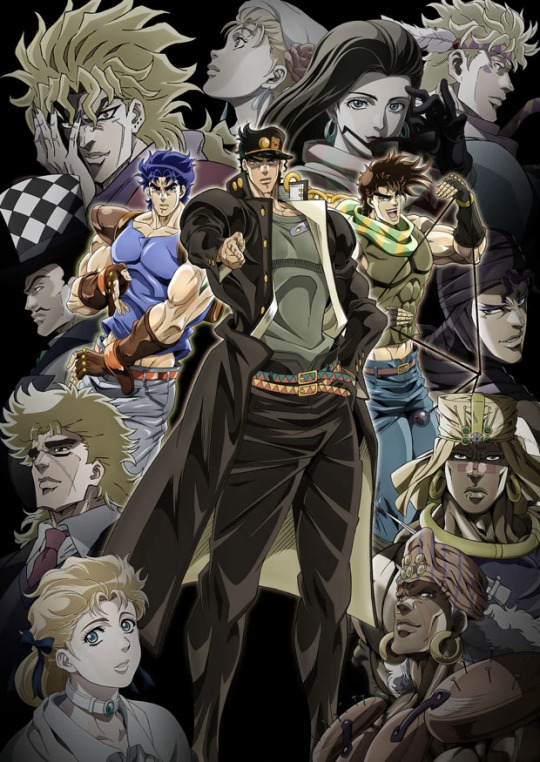
Gravity Falls on the other hand is just a fun and engaging mystery show that manages to excel at being episodic and story-driven all at once. There’s only one or two “bad” episodes across two seasons, and it lasted just as long as it needed to, wrapping things up with a satisfactory ending that still gave fans a few mysteries to chew on. It also gave us Grunkle Stan, perhaps the greatest character in all of animation, the pinnacle of “jerk with a heart of gold” characters who is hilarious, badass, and complex all at once. This is my favorite western animated show…
...but then the last year of the decade threw a curveball and, if I’m being honest, is on par with Gravity Falls: Green Eggs and Ham. Netflix really wanted us to know 2D animation is back in 2019; between this show and Klaus, the future is looking bright for the medium. It’s a fun, funny roadtrip comedy that knows when to be emotional and when to be funny, and it’s all filtered through the wubbulous world of Dr. Seuss. It’s just a wonderfully delightful show.

And on the subject of JoJo, I had a kind of love-hate relationship with anime this decade. The attitudes of anime fans turned me off from anime for a long while. Sure, I checked out stuff like Attack on Titan and Sword Art Online, but neither series really clicked with me. The main anime I loved this decade were ones that started in the 2000s and ended in the 2010s, like Dragon Ball Z Kai and Fullmetal Alchemist: Brotherhood. I suppose I did enjoy My Hero Academia, which is a really fun show with an awesome and varied cast and great voice acting. Love Froppy, best girl for sure.
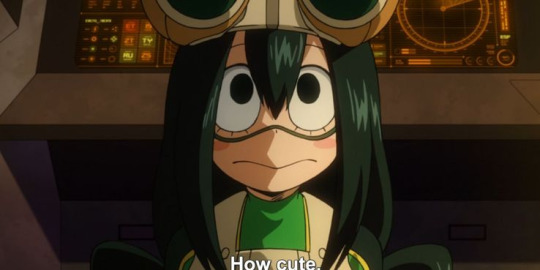
One of the most unfortunate things about this decade was how many great shows got screwed over by their networks. Sym-Bionic Titan, Thundercats, and The Legend of Korra were all great shows in their own right but were treated like shit by their respective networks. It really makes me upset that stuff like that not only happened, but continues to happen to this day.
But let’s not end on a bad note; let’s talk about the astounding returns old shows got. Invader Zim got a movie as did Hey Arnold, with the latter in particular finally wrapping up the dangling plot threads, but those are actual TV movies so they don’t really fit here; what DOES fit is Static Cling, the triumphant return of Rocko’s Modern Life. A forty minute special, it follows Rocko and his friends as they navigate the modern age, trying to bring back Rocko’s favorite cartoon. Rachel Bighead’s arc in this in particular is pretty groundbreaking and awesome.

Also awesome was the first few episodes of Samurai Jack’s return, though it did end up petering out halfway through the season and ended on an anticlimactic note. Still, Tom Kenny’s Scaramouche, the sheer amount of continuity, and the awesome final curbstomp battle against Aku are worth giving this a watch. And if nothing else, stuff like this gives me hope for future revivals. What will we see next? Gargoyles comeback? Batman Beyond continuation? KENNY AND THE CHIMP REVIVAL?! Chimpers rise up!
Music
Much like everyone, I listened to a lot of music this decade. There was a lot of shit, and I definitely used to be one of those “wow no one makes good music anymore” morons, but I grew out of that and learned to look in the right places.
Let’s start with the albums I loved the most. Continuing her meteoric rise from the 2000s, Lady Gaga drooped her magnum opus, Born This Way, an album that successfully showcases her skills as she takes on numerous pop styles. No two songs sound the same, and with a couple of exceptions every song slaps. While we’re on the subject of pop stars, Gaga’s contemporary and lesser Katy Perry managed to hit a home run with the fun bit of pop fluff that was Teenage Dream.

Weird Al was sorely missed for most of the decade, but what albums he did drop featured some of his best work. While Alpocalypse doesn’t hold up quite so well, it’s still solid, but even then it is blown out of the water by Mandatory Fun, an album that just refuses to stop being funny from start to finish. And that’s not the only funny albums this decade; aside from artists I’ll get more into later, George Miller AKA Filthy Frank released Pink Season as one of his last great acts as his character of Pink Guy. The album is as raunchy and filthy as you’d expect. And then for unintentional comedy, Corey Feldman dropped Angelic 2 The Core, an album so musically inept that it ends up becoming endearing; it’s The Room of music.

As I gamed a lot this decade I got to experience a lot of great video game soundtracks, but the two I found to be the absolute best were Undertale and Metal Gear Rising’s. I couldn’t tell you which soundtrack is better, and I’ve actually made a playlist on my iPod containing my favorite tracks from both games. Pokemon had solid soundtracks all decade, but they definitely were better in single tracks such as Ultra Necrozma’s theme from USUM and Zinnia’s theme from ORAS.
And speaking of individual songs, there were a lot I really loved. The disco revival in the easel ide half of the decade lead to gems like “Get Lucky,” “Uptown Funk,” and… uh, “Blurred Lines.” The controversy to that one might be overblown, but it sure isn’t anything I really want to revisit.

Corey Feldman may be the king of unintentional comedy, but this decade was seriously ripe with so bad it’s good music. The crown jewel is without a doubt the giddy, goofy “Friday,” but I think the equally stupid but also endlessly more relatable Ark Music production “Chinese Food” is worth some ironic enjoyment as well.
Meme songs in general were pretty enjoyable, though it came at a price. Remember when everyone tried to be funny by ripping off “Gangnam Style?” Remember when people took that Ylvis song at face value? Irony and satire were lost on the masses. I think the best mene song of the decade, though, is “Crab Rave,” a bouncy instrumental dance track with a fun music video and an absurd yet hilarious meme tacked to it. And then we have “The Internet is for Music,” a gargantuan 30 minute mashup featuring every YTMND, 4chan, Newgrounds, and YouTube meme you could think of (at the time of its release anyway),

Then we get into artists. Comedy music was great this decade, with Steel Panther and The Lonely Island putting out great work all decade, but by far my favorite funny band is Ninja Sex Party. Dan “Danny Sexbang” Avidan and Brian “Ninja Brian” Wecht are pretty much my favorite entertainers at this point, with them easily being able to go from doing goofy yet epic songs where they fuck or party to doing serious and awesome cover albums where Dan flexes his impressive vocals. A big plus is how all of their albums are easily some of my favorites ever, with not a single bad CD, and that’s not even getting into their side project Starbomb. These guys are a treasure.

Then we have Ghost, a Swedish metal band who play up the Satanic panic for all it’s worth. These guys captured my interest when I heard the beautiful “Cirice” on the radio, and despite that song rocking the fuck out, Imagine my surprise when it ended up being only middle of the road awesome for this band! With killer original songs like “Rats,” “Mary in the Cross,” and “Square Hammer” to a awesome covers like “Missionary Man” and “I’m a Marionette,” it’s almost enough to get a guy to hail Satan. I think they appeal to me mainly because they have a style very in line with the 80s, most evident on tracks like “Rats.”
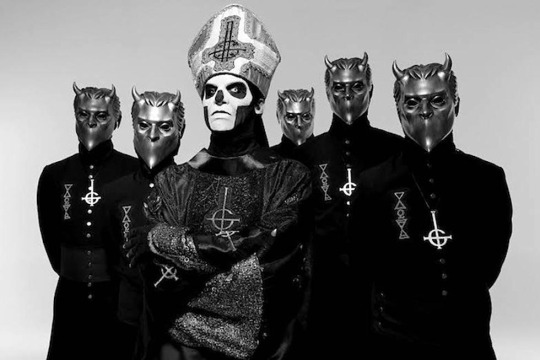
While I’d hesitate to call him one of my favorite musicians yet (he is really good so far though), one of my favorite people in entertainment is Lil Nas X. From his short but sweet songs that crush genre boundaries to his hilarious Twitter feed, this guy is going places and I can’t wait to see what those places are.
And finally, the guy I think may be one of the greatest creative geniuses alive and who has nearly singlehandedly shaped Internet culture with everything he does… Neil Cicierega. While it’s not like I only discovered him in the 2010s - the guy has been an omnipresent force in my life since Potter Pupper Pals debuted - he definitely became the guy I would unflinchingly call the greatest artist of our time over that period. Whether he’s releasing the songs under his own name or as Lemon Demon, you can always be sure that the songs are going to burrow into your brain. His Lemon Demon album Spirit Phone, which features songs about urban legends and the horrors of capitalism, is easily my pick for album of the decade. And then under his own name he released three mashup mixtapes: Mouth Sounds, Mouth Silence, and Mouth Moods. All three are stellar albums, but only Mouth Moods has “Wow Wow,” the bouncing track about homoerotic bee-loving Will Smith and outtakes so good they deserve to be on the next album.

Video Games
Having a PC this decade was great because it let me experience a lot of games I probably wouldn’t have otherwise, like Half-Life, BioShock, Earthnound, Mother 3, and Final Fantasy VI and VII. All of these and more are among my favorite games of all time now, but we’re here to talk about the stuff from this decade I consider great.
It’s hard to talk about this decade in gaming without mentioning Skyrim. Yes, it has flaws and the main storyline is a bit undercooked, but there’s so much fun to be had dicking about in the wilderness it’s hard to be too mad. And if you have mods, there are endless opportunities to expand the game. The same is true for the other game I have sunk countless hours into, The Binding of Isaac: Rebirth. Not only is there a thriving modding community, but it has been supported and encouraged by the creators and some mods have even made the leap into becoming fully canon! It’s always a blast to revisit and see how far I can break the game with item combos.

Surprisingly, Batman managed to get not one, not two, but THREE awesome licensed games this decade! Arkham Asylum, Arkham City, and the unfairly maligned Arkham Origins all kick as much ass as the Dark Knight himself. The former two reunite Mark Hamill and Kevin McConroy as Joker and Batman while the latter features numerous stellar boss battles. The combat in these games is so graceful and fluid, you WILL feel like Batman at some point, be it after flawlessly clobbering two dozen mooks or silently eliminating a room of thugs before they even realize you’re there.
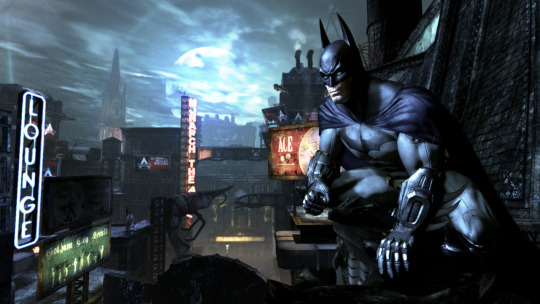
Pokémon had a bit of a rocky decade; it started out strong with the fifth generation, the best games in the series with a great story, region, and sidequests and then just went downhill from there. Not incredibly so, of course - the games were always fun at least - but gens VI through VIII were not the most graceful steps into 3D. Still, every gen managed to produce some of my all-time favorite Pokémon. Gen V had Volcarona, Chandelure, and Meloetta; Gen VI gave us Hoopa, Klefki, the Fairy type in general, and a gorgeous mega evolution for my favorite Pokémon, Absol; Gen VII had the Ultra Beasts and Ultra Necrozma, some of the coolest concepts in the series, as well as Pyukumuku; and Gen VIII gave us Cinderace, Dracovish, Dracozolt, Polteageist, Hatterene, Snom, and Zacian. And those are just samplings mind you, these gens are full of hits.
Bringing back old franchises yielded amazing results. Look no further than the triumphant return of Doom in 2016, which had you ripping and tearing through the forces of Hell with guns, chainsaws, and your bear fucking hands. This game is HARDCORE. Less bloody and gory but no less awesome was the return of not just Crash Bandicoot, but Spyro as well in remakes that are easily the definitive ways to experience the games. And don’t even get me started on the remastered DuckTales!
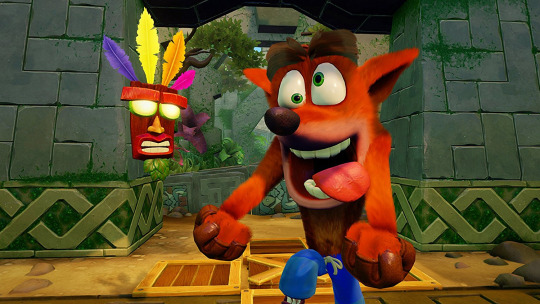
Platinum games did not fuck around this decade, delivering Bayonetta 2 and Metal Gear Rising. The former is a balls-to-the-wall sequel to the amazing original Bayonetta that, while lacking in bosses quite as impressive as the first game’s, is more polished and has a fun story and a better haircut for Bayonetta; the latter is an action game so insane it makes the rest of the Metal Gear franchise look tame in comparison. The latter in particular is in my top ten games ever, with every boss battle feeling epic, all the music kicking ass, and Raiden truly coming into his own as a badass.

Speaking of Metal Gear, the divisive The Phantom Pain easily earns its place here. While much fuss has been made about the game being “unfinished,” it still has a complete and satisfying ending even if it doesn’t totally wrap up the dangling plot threads the young Liquid Snake leaves behind. The overarching themes as well as Venom and his relationship with characters like Kaz, Paz, and ESPECIALLY Quiet make this game, with his and Quiet’s being particularly beautiful and tragic. The Paz quest, Quiet’s exit, and the mission where Snake has to put down his men after they get infested with parasites are all some of the most heartbreaking moments in the franchise. But it’s not all tears; there’s plenty of fun to be had harassing Russians in Afghanistan while blaring 80s synth pop from your Walkman. Oh yeah, and fuck Huey.
The Ace Attorney series also thrived, with both Spirit of Justice and Dual Destinies transitioning the series into 3D a lot more graceful than some other franchises while still maintaining the with and charm the series is known for. And if that wasn’t enough for my point-and-cluck adventure needs, Telltale had me covered with The Wolf Among Us and the first season of The Walking Dead. The stories and characters of those games are so good, it’s enough to make you sad they never got a timely sequel or sequels that weren’t shit respectively.
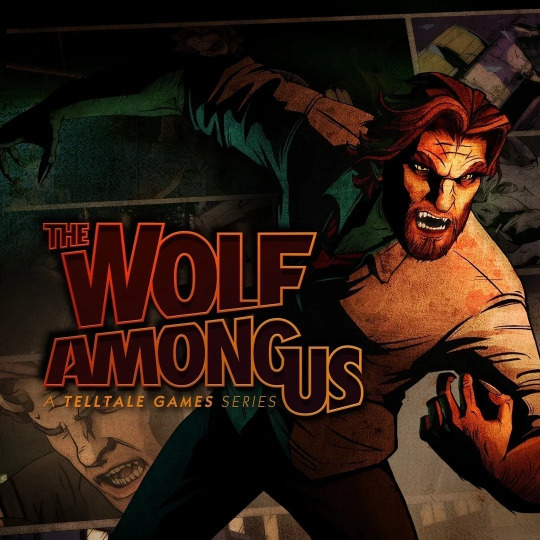
This decade is when I really got into fighting game, though I’m not particularly good. I supported Skullgirls (and am even in the credits!), and got into Ultimate Marvel vs. Capcom 3 and JoJo’s Bizarre Adventure: All-Star Battle (and I also got into its spiritual predecessor, Heritage for the Future). But by and large my favorite fighting game of the decade and the one I’m actually pretty good at is Super Smash Bros. Ultimate, the most ridiculously ambitious crossover in video game history. The fact that the game is STILL getting more characters added is a testament of how insanely great the game is because instead of being mad that there’s so much DLC, people are going rabid waiting for news of more. It’s such an awesome, complete game out the door that the DLC feels earned rather than half a game being held hostage. Other devs, take note!
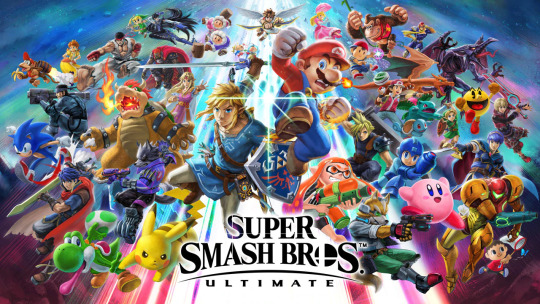
A lot of franchises put their best foot forward for sequels. God of War III was an awesomely bloody finale to the original journey of Kratos, with more epic bosses than ever; now he’s off fighting Norse gods, and I hear that game is even better! Portal 2 is just an absolute blast, and easily surpasses the first game on the merit of having Cave Johnson alone; the fact we get Wheatley and the malfunctioning personality cores honestly feels like overkill. Then we have BioShock… 2. While it’s certainly not as good as the first game, I think it was a lot of fun, and it got way too much flak.
I think it definitely aged better than Infinite which, while still a good game in its own right (it’s hard to hate a game with a character as endearing as Elizabeth), definitely was not warranting the levels of acclaim it got with such a muddled narrative. “Overrated” and “overhyped” are not words I keep in my vocabulary and I certainly would not describe Infinite as such, but I do feel like people got swept up in the gorgeous visuals and the story bits and characters that are effective and so weren’t nearly as critical of its flaws. It’s still a good, fun game with an interesting world, but it pales in comparison to the other two BioShocks. I feel like The Last of Us is in a similar boat. That being said, I couldn’t tell you why; it has a great story, good characters, plenty of replayability, and fascinating enemy design. But despite all that, I appreciate this game more than love it. It’s the Citizen Kane of video game sin that regard at least.
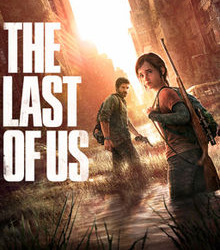
I’d be remiss to not mention the big indie successes of the decade. Shovel Knight is easily one is the greatest platform era ever made, taking everything great about the platformers on the NES and SNES, removing the bullshit, and delivering numerous bonus campaigns with unique playstyles. Then there was Abobo’s Big Adventure, a marvelous mashup of all sorts of games starring the beloved Double Dragon mook as he goes on a bloody quest to save his son. It’s a blast and there is tons of variety but some sections are definitely as hair-pullingly difficult as the games that inspired them. And then there is Doki Doki Literature Club, the free visual novel that brutally subverts your expectations. Sadly, I do feel the game loses some impact on subsequent playthroughs, but it’s still a great, effective story that skillfully utilizes meta elements.
Still, the greatest indie success of them all is Toby Fox’s masterpiece, Undertale. Charming, funny, emotional, and populated by a cast of some of the most fun and lovable characters ever conceived, this game was an instant smash and is still talked about to this day. Sure, things like Sans have been memed to death, but it’s hard to not just love and cherish the beautiful world Toby Fox managed to create. This game may not be the greatest game of all time, but for what it is I wouldn’t hesitate to name it the game of the decade.
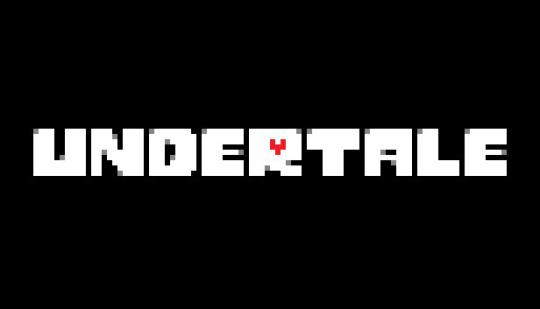
There was a lot of great art in the 2010s, and while I couldn’t get around to all of it, I’m so happy with what I got to experience. Here’s hoping that the 2020s can be just as amazing!
5 notes
·
View notes
Photo


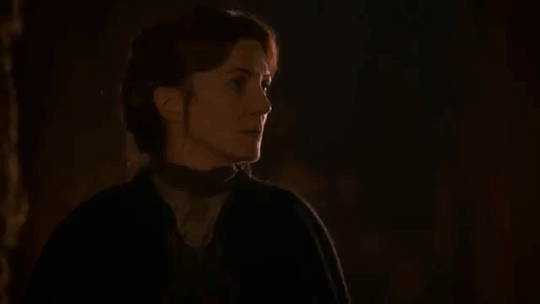

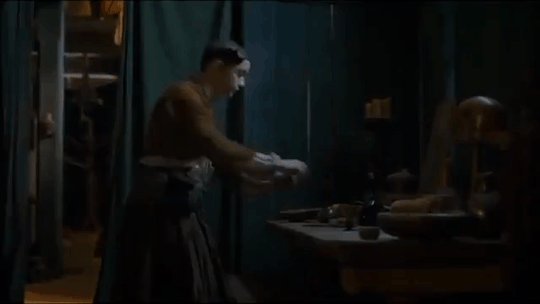

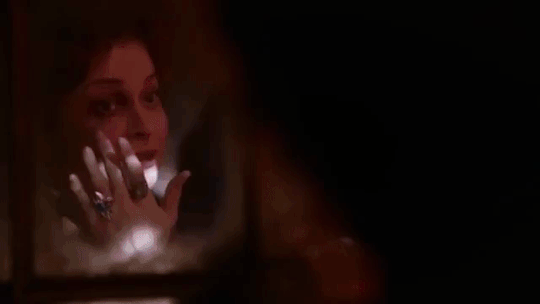
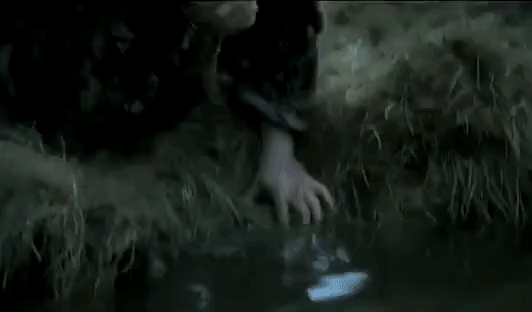
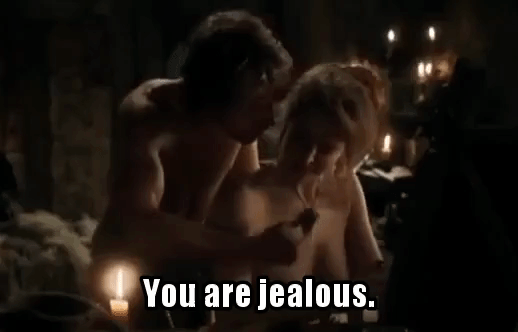

GRRM’s Much Ado about Mirrors - An Introduction
NOTE: The following is entirely speculation. Also in the latter portion of this meta, I will be introducing the possibility that a specific character has been tortured and sexually assaulted since season seven.
Within a story’s framework, mirrors can draw connections amongst characters and events and can convey conscious/subconscious thoughts, truth vs lies, etc. In a reference to the practice of hydromancy, The Lord of the Rings contains a basin of water, Galadriel’s mirror, that provides visions of the past, present, and possible future. Inspired by Tolkien’s device, GRRM uses mirrors not only in an allegorical manner in his series A Song of Ice and Fire (e.g. Sansa Stark as the positive mirror image to Cersei Lannister) but also to consistently foreshadow major events with water as well as to allude to previous scenes that haven’t yet been revealed to the reader (this will later compare to Melisandre’s pyromancy).
Of particular note, both Arya Stark’s confrontation with Joffrey Lannister alongside the waters of the Trident and Dæny’s clash with her brother Viserys in the midst of the “Dothraki Sea” serve to FORESHADOW THE CLIMAX OF THE ENTIRE SERIES.
GRRM successfully misdirects his readers and builds suspense though by also utilizing inversions, parallels, and consistently and purposefully leaving out scenes. Just as GRRM emulates and references multiple primary sources in his narrative, the show writers have looked at the most successful adaptations of the material that inspired him in their creation of the television show. In fact, this upcoming season will be tying together narrative threads in a major plot point that was seemingly inspired by Peter Jackson’s adaptation of LoTR.
Examining GRRM’s narrative techniques within the text itself and to his literary/historical sources reveals a great deal about Game of Thrones Season Eight, such as “The Kidnapping Plot”, “The Parentage Reveal”, “Will Dæny get her house with the red door?”
MIRRORS:
1. In the Series - Lady Crane is to Bianca as Sansa is to Cersei… AKA “THE KIDNAPPING PLOT”:
Jaquen H’ghar assigning Arya to rewatch her father’s death is certainly a reference to Hamlet testing Claudius; however it is also a mirror of the threats that Sansa and the Stark siblings/cousins will face in season eight. On stage, Bianca’s feelings and murderous plans for Lady Crane foreshadow Cersei’s targeting of Sansa. When the action moves back-stage as the actors remove costumes and wigs in front of mirrors, most of the doubles change but Lady Crane remains the stand-in for Sansa (e.g. the other actors’ comments that the crowd loves Lady Crane references book!Sansa’s pledge in A Clash of Kings: “... IF I AM EVER A QUEEN, I WILL MAKE THEM LOVE ME”).
The writers make this point irrefutable when they both acknowledge the criticism levied against them (Lady Crane: “The writing’s no good”) at the same time as they foreshadow how they plan on elevating the series from everything else that has come before it with Arya’s response: “(this story) would all just be (more of the same) without (Sansa the subversive heroine).”

Just as the threats to Lady Crane shifts, Sansa/the Starks will be targeted by a different force mid-way through the season when ALL of the Stark siblings/cousins will be involved in a violent stand-off, which will center on the FATE OF THE NEXT GENERATION OF STARKS.
2. To a Primary Source - Howland Reed and Petyr Baelish are the reconstruction/deconstruction of a trope and historical character:
Yes, just as Petyr Baelish has been ushered out of the action, the show will finally deliver Howland Reed!
Early on in season eight, Jon Snow will meet Howland Reed after trouble has ensued in the North.
(Leo Woodruff was cast as Howland as he had been on set for several years and wouldn’t attract any attention with his presence on set.) The show, as well as the book series, has quietly but consistently foreshadowed the ironic “event” in which Howland will enter the present narrative beginning with several comments from Robert Baratheon in season one and continuing on through Jaime and Cersei’s last argument in season seven. In fact just as some fans have noted that “The Spoils of War” mirrors “Hardhome”, Howland’s arrival should flip another notable scene (and reference an important moment in Westerosi history).
Given the nature and atmosphere of his appearance, Howland will not only privately discuss Jon’s parentage (the show’s opportunity to do a weirwood tree vision/flashback of the Tournament of Harrenhal) but will also reveal Ned Stark’s contingency plans
(the means by which this story will starts to conclude its theme of the futility of war… for more details, see the section on parallels between Ned and Doran Martell). NOTE: This meta on Howland Reed and Petyr Baelish will be part one in this series.
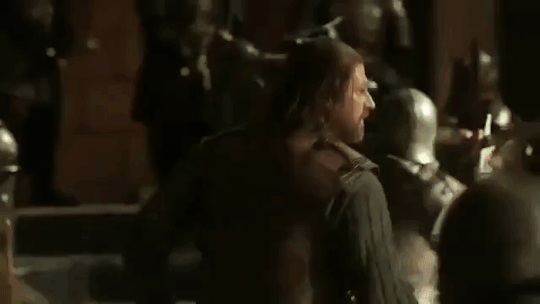
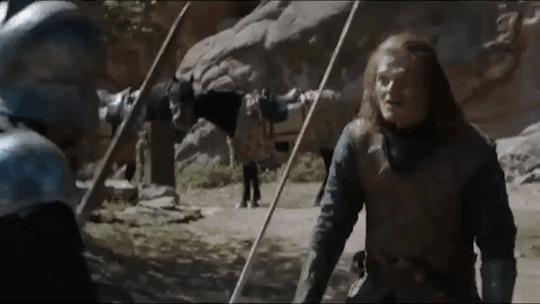
INVERSION:
1. In Show/Series - Jon Snow and Jaime Lannister:
There are many metas on the connections between the two; however I haven’t seen one yet explore the respective secrets that both characters have NEVER disclosed to anyone; it is those secrets that have largely dictated their individual characters arcs and are the main reason the show has the two having a conversation with each other in season one. To be sure, Cersei’s line about Jaime being the “stupidest Lannister” in the last episode of season seven will in retrospect be ironic. These narrative threads should be exposed with all the action and fallout surrounding “SANSA’S GIFTS” early on in season eight.
2. To a Source - Dæny and her character’s main inspiration:
Dæny was not only partially inspired by a Shakespearean MALE CHARACTER (there are very few, if any, one-to-one correlations) but her narrative will ultimately contain elements from one of the most well-known and subversive adaptations of that particular character. Coincidentally, as Dæny is the inverse of the main male character, Jon Snow is the positive mirror of one of the main supporting characters in the same play. GRRM’s purposeful lack of additional POVs in Essos can make it difficult to recognize that her narrative arc not only takes her full-circle but has her regress; however it should be irrefutable upon her final conflict, which has her face the same question as many of her predecessors: “What do you do with the children of those who threaten your power?”
Dæny’s clash with the Starks over this question is the MOST VISUALLY REFERENCED SCENE in the whole tv series.

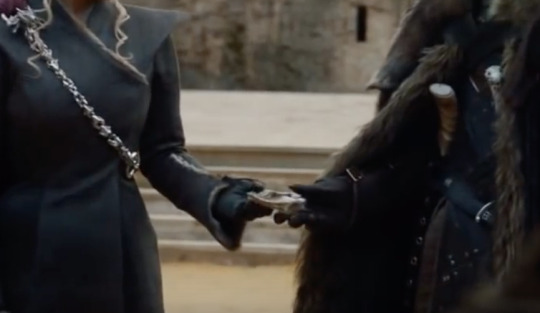
(THE COLOR OF THE EGG IS IMPORTANT.)
PARALLELS:
1. In the Show/Series - The Plans of Ned Stark and Those of Doran Martell:
Due to the trauma that they both experienced during Robert’s Rebellion and their steadfast love for their sisters, both Ned Stark and Doran Martell worked steadily and inconspicuously towards shoring up separate plans for their respective families. Besides recruiting their younger brothers’ help and their focus on strengthening political alliances in their respective regions,
THE CORE OF EACH OF THEIR PLANS RESTS ON A SECRET MARRIAGE BETROTHAL.
Unfortunately, their differences (Ned is for protection/reactionary and Doran is about vengeance/aggression) may lead to entirely different ends for their houses (I’m still holding out hope regarding Sarella’s future collaborative efforts with Samwell Tarly and Marwyn and her eventual governance of Dorne). Ned’s contingency plans should not only hint at an ironic ending but at the theme of the futility of war.
2. To a Source - Varys and his character’s inspiration:
Despite the substantial differences between show!Varys’s plot and his counterpart in the book series, his ties to his character’s main inspiration remain intact - his secret identity and his visits to political prisoners. These core characteristics will lead him to be an active participant in his death, similar to his narrative source; in an ironic twist, Varys will end up aligning with the Starks and will save the life of one of their most important allies with the help of Melisandre. Varys is another testament to GRRM’s belief that anyone can make the choice to be heroic.
MISSING SCENES -
GRRM intentionally leaves out critical scenes throughout his series as it enables him to surprise his reader. Because it would be too obvious to leave out the most important scenes, GRRM does it in MANY instances. “Why don’t we have more insight on Sansa’s female relationships?” “Why don’t we have a chapter with Catelyn saying goodbye to all of her children?” “Why don’t we have a Dothraki POV?” The writers for the show have successfully used this device since season one. It isn’t until season seven though that the show makes it evident that some of the most important scenes are not always shown to the audience.
It may seem like the writers are cheating the audience with leaving out scenes, but they have always provided us with ALTERNATE VERSIONS OF WHAT IS MISSING.
1. In Show/Series - Ramsey is to Theon as Yara is to Euron:
Once Yara is taken captive and paraded through King’s Landing, the audience doesn’t get to view another scene with her nor learn second-hand what is happening to her. Theon does express two beliefs about his sister’s fate: 1.) Yara is still alive, and 2.) Euron is holding her captive rather than Cersei. However, Euron’s comment to Yara in season seven about the King’s Landing crowd (“... THIS IS MAKING ME HARD”) along with book!Aeron’s terrifying memories of Euron visiting his bedroom at night (”No mortal man could frighten him, no more than the darkness could... nor memories, the honest of the soul. The sound of a door opening, the scream of a rusted iron hings. Euron has come again.” A Feast for Crows, “The Prophet”) indicate that
Euron not only commits gratuitous violence against his ship’s captives but that he enjoys sexually assaulting his family members.
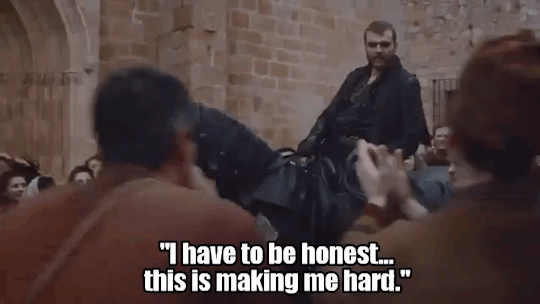
Is that enough foreshadowing for the tv show’s general audience? Perhaps it isn’t, which may be part of the reason why the show writers decided to repeatedly show graphic scenes of Ramsey torturing Theon... those scenes also serve as a stand-in to what Euron is doing to Yara.
What would be the purpose of delaying this revelation about Yara? The most obvious answer lies in a conversation that Theon has with Ramsey about his father during season three: “Those men, they said that my father knew what they were doing to me.” As the audience knows, Balon Greyjoy does learn what is happening to his son and still refuses to him him.

If Ramsey and Theon are a stand-in for Euron and Yara, then the audience can extrapolate that THEON IS AWARE OF WHAT EURON DOES TO FEMALE CAPTIVES (EVEN THOSE RELATED TO HIM) AND EXPLAINS TO DAENY WHAT YARA IS EXPERIENCING. We also know from the Dragon pit meeting that Dæny does not ask for Yara to be returned.
This possible narrative may lead the audience to unexpected topics: Will an abortion be part of the plot in season eight of Game of Thrones? If Yara has been the subject of Euron’s heinous, violent acts, what does this mean for the other familial pairing - Jon and Dæny? Jon’s arrival at Dragonstone and his departure for Winterfell does roughly correspond to the same time frame as Euron taking Yara hostage and Theon heading off to rescue her.
Thus, are Jon and Dæny a MIRROR of Yara and Euron, or are they the INVERSE of one another? Was Jon summoned to Dæny‘s room? Or did he come of his accord? Is the show exploring the topic of “submission vs consent” with two of its most popular characters?
2. To a Source - “Sansa’s Gifts” and Peter Jackson’s The Lord of the Rings Trilogy:
Similar to Dæny and Cersei respectively in seasons five and seven, Sansa will receive “gifts” from someone who is trying to convince her of his/her loyalty towards the end of episode one or towards the beginning of episode two. Not only will this complete the “rule of three” for all of the queens in the last season, but this plot point was inspired by a narrative device that Peter Jackson created in adapting The Lord of the Rings.
To maintain the surprise of this plot twist, the show left out TWO CRITICAL SCENES that happened early on in the series. Just as Theon and Ramsey are a stand-in for Yara/Euron, there are two scenes that serve as a double for the ones that the audience will never see; however those scenes have been alluded to, and the audience has witnessed evidence that they occurred.
This show’s writers have been planning this since the beginning, and “Sansa’s gifts” actually fits ALL of the narrative devices mentioned in this meta:
Mirror (In Show AND Source Material)
Inversion (In Show AND Source Material)
Parallel (In Show AND Source Material)
It also INSPIRED ALL OF THE “GIFTS” THAT WERE CREATED SPECIFICALLY FOR THE SHOW, including the thimble Sam gave Gilly, Ellyria sending Myrcella’s necklace to Cersei, Davos giving his carvings to Shireen, Littlefinger bringing a falcon to Robyn Arryn, etc.
Truly, the narrative impact that this will have on the outcome of the entire series cannot be overstated. Just as Ned’s death overturned the audience’s expectations as it also impacted the trajectory of the entire narrative, so will “Sansa’s gifts”.
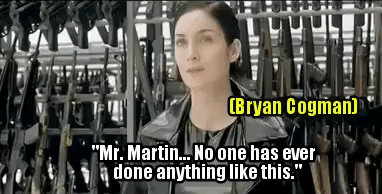
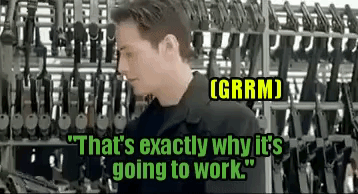
#cw: violence#got s8 speculations#jon snow#ned stark#sansa stark#jaime lannister#howland reed#theon greyjoy#yara greyjoy#varys#game of thrones#got#grrm x rule of three#petyr baelish#ramsey snow#euron greyjoy#grrm's much ado about mirrors#lady crane#arya stark#stark solidarity#cersei lannister#galadriel's mirror#doran martell#melisandre#samwell tarly#varys the spider#sam the slayer#house stark
22 notes
·
View notes